New release of First Generation! The Crooked Man’s analysis!
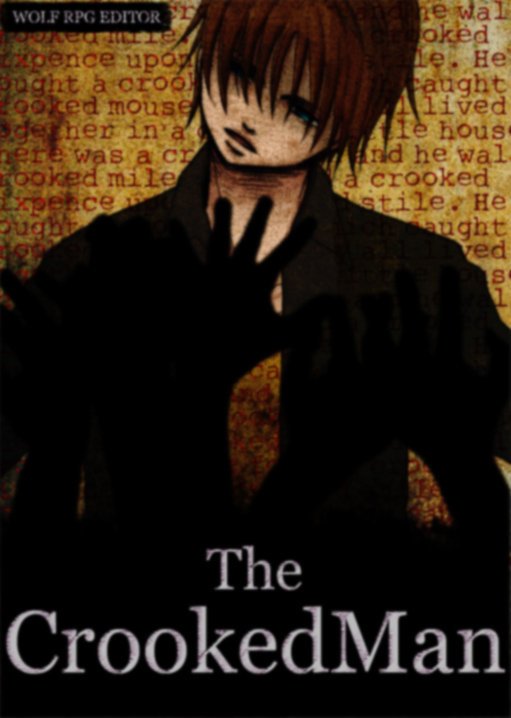

New release of First Generation! The Crooked Man’s analysis!

New release of First Generation! Mad Father’s analysis!
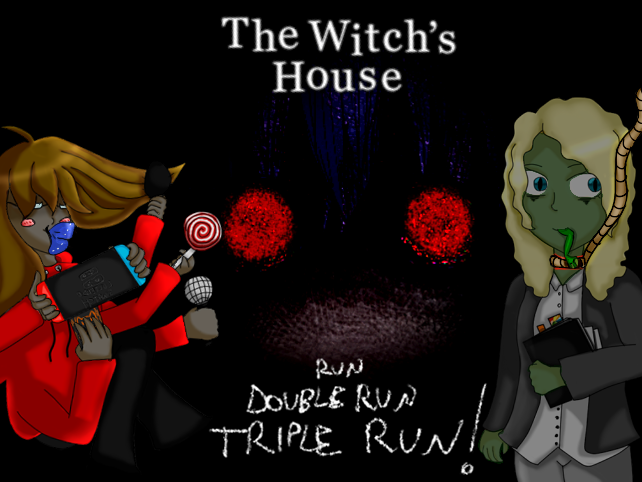
Well well well. How to write a decent introduction for this game?
Yes, that’s what you read from the title and the cover. In short, the great The Witch’s House. We cannot convince you to enter this godforsaken house as if nothing had happened, with the risk that you would not come out alive …
…
We’re so nice.
Probably in this article we will repeat ourselves a lot in the concepts, this … What can I say. It was simply a game we continue to replay, the ones we re-play more often than the classic Horror RPGs.
At the level of settings it is one of my favorites (PaoGun) while Ele tinkers with the puzzles, both immersed in the dark rooms of the house and in the right bgm of Presence of Music (practically the site if it has been stripped of everything!). A game that immediately knew how to make a good impression for its technical virtuosity and elegant style (if not as strong in graphic personality as Ib) that won the hearts of many fans of the genre that was starting to form as an RPG Horror.
A game in which it will surely have been the only case in which … Let’s get to the joke…
Yes. The only case in which the player enjoys a second run to collect all the deaths of their character!
Ahahahah, we like to joke a looot today.

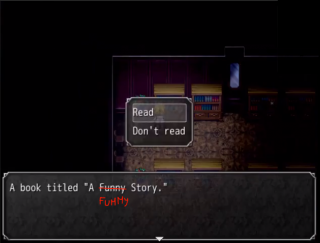
….
I always wanted to do this.
Okay now I’ll hang myse-
Alright! Here we are!
What was the distribution path of The Witch’s House? As always, Ele will unfold in the chronology of events, accompanying you this time to discover the trump card that made this game one of the most popular HOR-RPG titles!
Okay, being a classic, the release date of The Witch’s House is also very precise, and perfectly findable on any wiki: October 3, 2012.
As well as Ib, the title was released only on the official website and on one large Japanese distribution platform. In the case of The Witch’s House, that platform was “Freem!”

Nothing new: it is a platform that hosts indie games (also other titles of the HOR-RPG genre, such as Candle) as we have already seen, such as freegame-mugen.jp
From Freem! The game has obviously spread from Orient to West, earning as always many dedicated gameplay and videos on Youtube, NicoNico Douga and other sites, along with a very positive welcome in general. It is in fact considered one of the “masterpieces” in the field of games made with RPG Maker (qualitatively it is often compared to To The Moon, another pillar of the narrative title made, however, with RPG Maker XP) and a cult of the horror game in general by way of the elements that we will see in the Trump Card paragraph.
Compared to Ib, which as ancillary works had alternative versions, or limited merchandise at certain times of the year, Fummy wanted to aim higher. In addition to having a part in a kind of haunted house in Nico Nico Chokaigi Festival in 2016, with The Witch’s House we have a phenomenon that will repeat for many of the most popular HOR-RPGs that we will cover here…
The phenomenon of light novels!
Small premise: I will consider the manga and the light novel one thing in the following lines, since the manga is heavily based on the novel.
“So? Yume Nikki also had a light novel, why is this more important? “
It’s simple: this novel doesn’t just use a different medium to tell the story told in the game … But it’s a prequel to the title itself. In fact, the novel (released on October 31, 2013) is called “Ellen’s Diary”.
But despite being a slightly different case from Yume Nikki, from the point of view of the events that happen we have the same problem: it doesn’t do justice to what happened in the game. Ellen’s character has been heavily distorted, the total vibe has changed … But we will better see the results of this commercial operation in the Author-Work Relationship.
But Fummy didn’t stop there. About five years after the release of “Ellen’s Diary”, on the same day of the year, a remake of The Witch’s House, made with RPG Maker MV, was released on Steam … And with the name of someone else under Fummy’s.
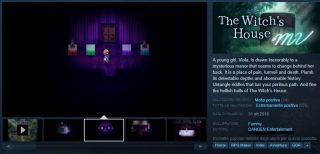

That’s right, guys, even Fummy has arrived to a publisher! Wow… We didn’t see them since Corpse Party! So in 2018 DANGEN Entertainment (also publisher of Crosscode and other indie titles) took over the remake of The Witch’s House.
As main changes we have, as you can already see from the screenshot, many modernized graphics, from the sprites to Viola and Ellen’s facesets and, much more important on a practical level, the addition of two further levels of difficulty, which can be decided before starting the game.
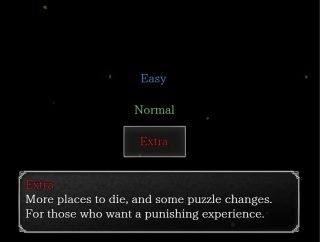
The most interesting mode is the “Extra” one, which can be obtained at the end of a game in normal difficulty (I don’t know if it is still possible to obtained if you played the “Easy” mode), where in addition to the increased difficulty there are some elements that can allude to the minimum background given from the light novel.

But, if I have to speak personally, I really appreciated one thing about this remake, which raised the Professional Meter by a few levels, which you will see later.
These changes of puzzles, and in general the elements that allude to the light novel, are only characteristic of the “Extra” difficulty of the game. If you simply want to relive the experience of the original work with elements that only improve the general aesthetic of the game, you can do it in Normal mode.
Maybe Fummy wanted to somehow keep their first work untouched, and treat the past of that distorted Ellen that he always had in mind as something additional, not as something that must be followed obligatorily (as happens with many remakes or sequels, which make additional plot elements mandatory, integrating them heavily with what was the original game, example: Corpse Party): The Witch’s House is always the cult that we met in 2012 with RPG Maker VX.
But from a more internal point of view, studying the title itself, what actually made The Witch’s House a title that not even the author theirself, if not with a whole other mode, felt they could modify?

Now, therefore, we are faced with a true master who has been able to bring together two fundamental elements for a quality (video game) work: reconciliation between gameplay and narration.
We have already mentioned in the Product History the merits that have made this game so acclaimed by critics and the public: the atmospheres, the ingenious puzzles, the good use of jumpscars … In addition to the graphics that already in the original version left many “makers” and players with their mouth open because of the good use of parallaxes especially for external environments, the big quantity of animations for the sprite of the protagonist Viola…
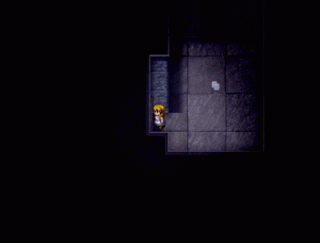
… With also added puzzles that, although not too difficult, have nice concepts behind them, together with a nice sense of contentment by the player when they solve them…
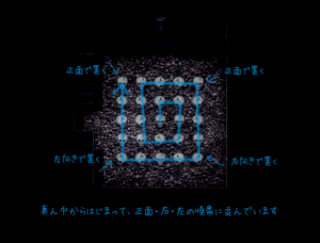
There is still one more element that has made this game a classic of the HOR-RPG, and in our opinion also in 2D horror in general: the narration-

Ah, don’t be so blind! I don’t mean this scene!
Sheesh, I didn’t even finish talking: I mean the managing of the narration until the ending.
For most of the game, we don’t have many non-system dialogs. This is a very important factor, because it makes the distribution and management of information much more successful than many fictional works in general.
Why in many of these fictional works the information given to the spectator (or player, or reader, we speak in general) are told in a “banal” way, at least for me? Here, let me explain: too many times it happens that the player (in the cases we will talk about) is flooded with information given all at once by a single cutscene with many words that come out of the mouth of the characters who, in that scene, become mere reservoirs of information: even if the player feels that they have discovered all the info on a situation, a character, etc … The aforementioned cutscene becomes heavy, difficult to follow and tiring on a psycho-perceptive level in the long run.
Here … What gives Fummy an extra point from the point of view of writing (in the original game, we have already seen what confusion he did with the light novel) is just the opposite of what I said. But let’s take some examples, it’s easier to understand this way.
As a “bad example” I took one of the most striking cases, one of the worst cases, but what I described above happens in many works not necessarily of bad quality, but which have this basic heaviness in disseminating information.
Let’s take an example of how a character’s past is described in, for example, Corpse Party (1996) and The Witch’s House.
Corpse Party’s mid-point: do you remember it?
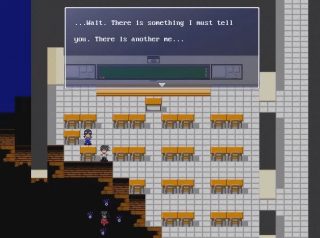
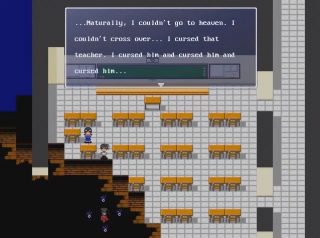


I put a few screens, to recall the article on Corpse Party, which we have already talked about here in Back to the Future, but this cutscene lasts much, much longer. Here we have the speech I mentioned above: the information is given all at once, in the worst cases without details that can allude to certain plot details or characters.
Yes, practically a certain type of wall-of-text.
But let’s see The Witch’s House now
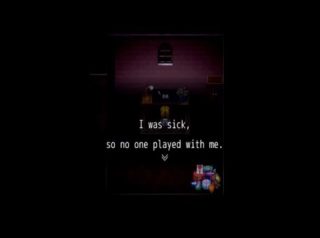

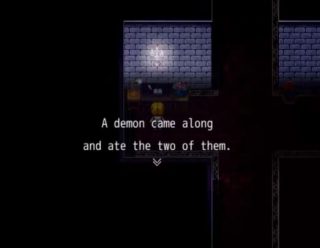
For now, we don’t care about the content of the information … But did you notice a big difference between how the story of the two girls, Sachiko and Ellen, is told? In The Witch’s House the narrative goes on in many different places. Ellen’s story goes on if the player goes on: they don’t remain glued to the space bar of the keyboard to go on in the endless dialogues of the “explain” cutscene.
The information given in this way also gives a very good curiosity effect in knowing how the witch’s story goes on. The final revelation in the Witch’s last diary is even more powerful, as you connect all the dots that were given to you throughout the whole game, for the duration of your entire experience with the game.
An unprecedented title in the field of HOR-RPG, which has been able to convey 360 ° the emotion given by dissecting a story during the playful and interactive experience as only a video game is capable of doing.
A Trump Card that we can define … Two in one.
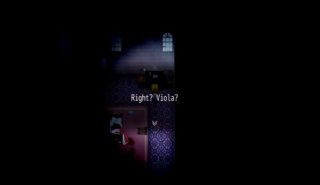
“Aahh, F*CK!”
-Average The Witch’s House player in this scene
With this reaction, the effect that information managed in this way is very evident: we finally meet this “Witch” always mentioned in the diaries, and she is also directly connected with Viola: throughout the game there is an increasing tension given by the waiting to know his identity.
Here, for this I ask all of you readers to think that the good narration of The Witch’s House is in the whole game, and not only in the final scene (because it is common thought that the story of this title focuses entirely on the final “reveal”).
In that scene, we have fallen into a much more exaggerated dramatization, which we will henceforth call “soap-opera dramatization”. Effective music, Ellen’s villain monologue …

…
“Muahahahahah”, I would add.
… My God, not even the weather is on the side of poor Viola and is the bird of ill omen saying “in this exact scene you will die among the players’ tears!”. In short, for this scene there is a “moved-or-nothing” vibe. We only should have TEARS OF PAIN.
Here, keep this type of direction in mind for the next article …
In the meantime, before moving on to the other ace to analyze, I would like to make a note.

There is a very important element to be considered within these games, which we have perhaps not explored sufficiently in the previous article: have you noticed how unlike the three games of Generation 0, enemies have a more ambiguous nature?
Not even Akemi-Tan had the same treatment for them, there was a division between “good and bad”, faction of good and evil. In Ao Oni there was a demon as a definitely negative element, Yume Nikki remember how he pushed himself more on an experimental and immersive approach without wanting to keep realistic tones in the least.
Leaving aside the case of Corpse-Party (the ’96 one, whose plot focused on spirits to be pacified, an ancient tradition of many horror works, centered on a more human sphere of characters), we can already see in Ib the difference: some works of art give you the game over, others don’t. Mary suffers from loneliness, Ellen suffers from loneliness and seems to complain of a lack of affection. Complexity grows in the gaze we have to turn to the characters: they have intentions and motivations that start from within. Human needs and needs that we spectators experience every day (desire for companionship and sociability or affection, just to make examples) but that pushes the characters to perform strongly negative (and often atrocious) actions and bad examples that they show us with a horror staging.
In particular, this growing ambiguity will also be noticed in Sen’s works, Mad Father (precisely: a murderer who wants to put himself also in the position of a parental figure) and Misao (in which we move more and more towards the ” daily normality “of the context), going from here on to articulate characterizations of increasingly complex characters up to even the pattern of the Journey of the hero in The Crooked Man and the articulated facets of the characters of Cloé’s Requiem in the generation to come. But this will be a story that we will deepen later, step by step.
Since, in this case, dwelling on the behavior of the two girls would not add anything to the analysis that you don’t already know (apart from admiring Viola’s determination and being interested in Ellen’s sociopathy) will not be The Witch’s House the game that will make us talk characterization of the characters, at least for now…
… This is because it is not a title that has only narrative. Even from the point of view of the “video game” in its most primitive sense, The Witch’s House has offered a very important element (which, alas, is missing in many HOR-RPG or pseudo-such titles of today), more pleasant to play, and you also deal more difficult. There is no question why Fummy wanted to accentuate it even more in the Steam version of the game …
The replay value..
“Replay value is a term used to evaluate a video game’s potential for the value of the game continued after its first conclusion. The factors influencing replayability are extra game characters, secrets or alternative endings ”(from Wikipedia)
I already know what you are thinking.
“But Ib also has 9 different endings!”
And you are right! Ib also has a relatively good replay value, but what makes The Witch’s House even better than Ib from this point of view are not so much the alternative endings (even if The Witch’s House has 3 of them, not counting the “_____ ending” added in version 1.07), but rather the first two things mentioned in the definition: extra and secrets.
Being the game itself not very long (average of 1 hour and a half), Fummy was able to add all sorts of secrets, details or endings that give meaning to a second, third, fourth or fifth run. Here is everything you need to “have the platinum” of The Witch’s House, discovering almost every secret.
– Get the “good” ending;
– Get the real ending;
– Get the “_____ ending”;
– Check all the books that appear gradually in the library going forward with the game, instead of continuing indefinitely from floor to floor;
– Delete the “PublicData” file from the game folder and therefore in the distraction room you can have dialogues with the black cat;
– Collect all deaths.
And also, in the MV version, finish the game in all three difficulties: Easy, medium and Extra.
In addition to this there are also many small details that perhaps in a single run a player may have certainly missed. For example, I never noticed this bottle in the medicine room.
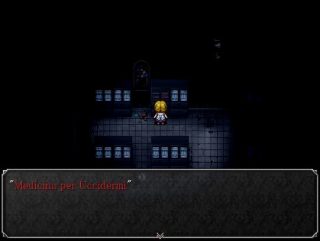
“Medicine for killing myself”
So, speaking in more practical terms, in addition to the endings there may very well be other “trophies / objectives” to be obtained during the game, and this greatly multiplies the possible runs (even if the quantity varies, it depends on what the player has missed during the first one).
In short, the numerous layers of which this title is covered (the multiple narrative levels and the multiple variations of playability) have made it iconic in itself.
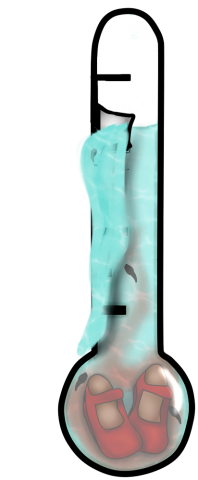
Well folks, what can I say? The thermometer here is quite high.
Of course, it’s still difficult to go back to Corpse Party’s levels … But the approach begins to be different from the other games we have faced in Back to the Future.
In reality it is a theme that we will better deal with in the Author-Work Relationship, in which we will try to better explain what happened with this title when we talk about inter-medial passage.

This is certainly a very unusual title screen: here we are only in front of an expanse of colors.
The shades are cold, ranging from blue to green and probably refer to isolation in nature in which the game immerses us in the first frame in which the protagonist appears.
This recurring theme with nature reminds me another cover …

Yes. Yes, exactly.
Here, it is as if the game itself wanted to suggest a return to nature, a fairy of the woods who then became a witch: nature that from a benevolent mother “able to wrap us in a carpet of flowers” then becomes malevolent, “directing us creatures that they devour our heads in bites ”.
Mother Nature has been cruel to Ellen and her illness, her state seems to refer here almost to a natural component with herself.
As well as Viola, who lives in the woods and is represented as this daughter of a hunter, this blonde girl who ventures through unknown paths and rose bushes. A section of the game is also dedicated to the garden of the witch’s house, and in particular we can remember the riddle in which the player is forced to tear away some white talking flowers from the ground.
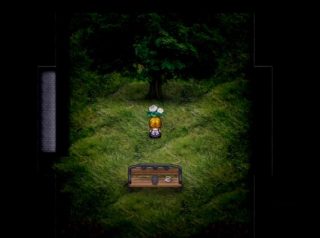
This can be an interesting field of comparison compared to the urbanized context of Ib, in which the style seems to want to approach minimalism and in some ways abstractionism (in this it shares a common point with Yume Nikki) unlike the representative context that is been chosen for this game.
After all, the menu and interface are quite simple, all our attention must be focused on the gaming experience.
The packaging therefore, and the way in which the title is presented, is one of the reasons why, although the style is recognizable, we have not yet raised the level of the thermometer a little more.
In any case, the explanations for which the water level is so high compared to the previous games we discussed are in the following paragraphs …
Okay, we finally got to this point.
To begin with, there is one thing to consider compared to the other authors we have named in Back to the Future: Fummy seems much more present and master of the work (and the franchise he tries to build).
Some will remember what we said about Makoto Kedouin in Corpse Party, or kouri in Ib, the total disappearance of Kikiyama, or even the detachment of noprops.
We are not referring only to the remake that came out for a fee and with a certain distribution operation supported by the publishers with lots of different translations (the only one perhaps in our opinion that has maintained a high quality level and has been able to properly support the comparison with the original title), but also to other ancillary works.
Yes exactly. Again, we are talking about the light novel and following the resulting manga.
“Ellen’s Diary”. The events seem to have moved to a more dramatic level (this can be seen in the decisive features of the drawing in the strongest scenes and in the light-dark tones that we preferred to adopt, my compliments to the artist) and slice of life, as saying: flashes of daily life not told in the game.
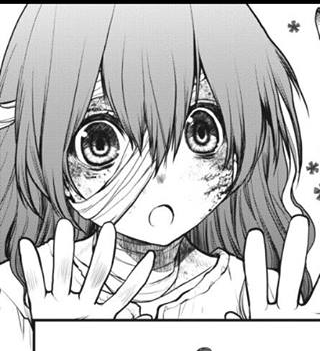
Well, yes, in short. This is the cute and cuddly vision we should have of this sicko before she sold her soul.
You can see that this “sweetening of the pill” made me really mad, eh? Yup. Nothing can be hidden from you all.
You could tell me that “it is natural that we should see her in all her innocence”, and I answer that this is not innocence but fanservice that distorts the character. Come on! A little girl who lives in conditions of misery, illness and who begins to develop an obsessive-possessive feeling towards her mother (but also just for the life condition she faces), how the heck do you catch me in this shot with rounded shapes, wide open mouth and shiny eyes for seeing a kitten? If I remember correctly, it must have been a cat while devouring a mouse. A hunting scene.
Okay, it doesn’t matter. We try to get to the heart of the matter: what we are trying to say is that, even if the tones seem to have shifted to the most dramatic and certainly less broadly communicative level (the slices of life are not exactly those types of genres that can be selling to a mass audience, especially if there is no defined plot) it is a smart move, it is an attempt to “build the franchise” to be taken into consideration.
This is what basically what “markeatable” works do. Everything is related to the loyalty that is created by the public, and it has been remarkable that it has been applied to The Witch’s House.
This is why we have been generous with the professional thermometer score. The game is clear in its intentions, it offers an immersive and interactive experience, then building from that world that created a new story, in this case Ellen’s past.
The remake I believe, seeing it in this perspective, that it was simply part of a strategy to try to refresh the title as well as a way for Fummy to test him/her self with a different engine. We appreciated the fact that in the remake there are no further insights into Ellen’s past, for us it represents a considerable seriousness towards the work.
The strategy applied by the author is remarkable, they maintained a certain detachment from the product but tries in every way to enhance its content in different forms by exploiting the intermediary through which a fictional work can be realized (you want whether it’s a light novel, manga or video game) respecting the language that these different expedients require.
Well, we are happy to declare that this work has no flaws!
It is from Yume Nikki’s article that we did not pronounce this satisfactory sentence.
As always, I will try to explain myself better to the most skeptical readers.
So, surely someone could notice some flaws inherent for example to the plot. Indeed, it is more than plausible that someone notices how unthinkable it was for Ellen to have been able to continue the diary even after the exchange of bodies.
You are completely right. This is a flaw.
If we want to offer justifications, it could also be assumed that there was a moment to fill in these last pages, perhaps as a testimony of the “last drop of Ellen’s sanity”, or a personal note that she made to conclude “her path as a witch”; but these are only hypotheses like others, there could be different ones and it would be a great challenge to try to cover this plot hole.
In reality there is another flaw, in my opinion even more serious.
I refer to Ellen’s statement: “the house has helped me from the beginning”.
Exactly, where would the witch’s house favor her ex-owner by letting her continue the gameplay? If the game kept us, it would have been easier to specify that the house became an obstacle because he simply hadn’t recognized it, and that was a special routine that the common victims of the witch would follow if they weren’t killed.
However … Yes. We continue undaunted to claim that “the game has no flaws!”.
This is because these are not narrative errors as serious like Ib’s errors, for which it would have served to elaborate the construction of a complete world-building. We remember the perception of the lighter and then the damage to Mary’s picture or the rule of the two people: two forgetfulness that could have (or risked) give a totally different tone to the end of the game if not to change the nature of the game itself; unlike The Witch’s House’s defects. The errors deriving from the attempt to know the logical correctness of the off-screen chronological events or from seeking an approximate justification for the events related to the individual puzzles that occur during the game are not types of defects that compromise the nature of the game.
… If I seem so understanding towards this work, it is for a specific reason.
Unlike Ib, The Witch’s House knew exactly where it wanted to go.
We are not provided with very rigid or particular types of details on the context in which the story is set, we are not given particular rules on how the house functions: the experience we went through is a videogame fairy tale.
A fairy tale that breaks the tradition of Hansel and Gretel: houses in the woods, the evil witch and the inevitable haunted house that are the protagonists of a story in which we interpret the evil character.
There is Ellen’s story that is deepened by her diaries, and this is another breaking point with the traditional fairy tales in which the characters are strongly characterized and stylized, but this does not detract from the way the girls are represented to us. Note when entering the dark corridor, for example.
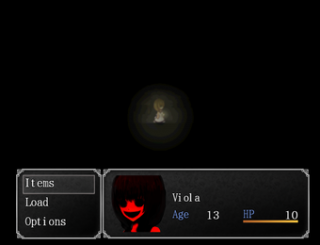
The screenshot is from the remake of the game
With all the information posthumous from the first run, what seemed at the beginning to be a normal disturbing element of the house, we can now associate it with Ellen’s connotations: red with a black grin, practically a demon. After all, “if she’s bad, it is right that she’s represented in this way”.
In addition to the dull look that can be seen from the menu interface similar to another essentially negative feature.
This game has fully centered the characteristics that define a quality game, as we said: a brisk, multi-layered narrative (remember what we said in the Trump Card on replayability) stuck properly in the tensive gameplay session, and it doesn’t separate the two elements drastically.
Having made full center for both sides, we cannot fail to praise the excellent work that has been carried out, to which added up the strategy on the “construction of the franchise” (even if it is not an operation yet completely successful, for the content of the work itself) makes it an excellent product and an interesting case of commercial experimentation.
We have also come to the end of this article. 2012 passes quickly, the time machine is moving at the speed of light from February to October and from October to December we come to the end of the year…
We have already noticed a difference in the way Ib and The Witch’s House approached the challenge inherent in the “storytelling” within an exploratory video game. On the one hand, a more patchy approach, while on the other we have a refinement of the method …
And not even two months later, in December, in this current it will spread a game that will boast the narration of dramatic events, told once again from the point of view of an anti-heroine.
… We are talking about the second great watershed in the history of Horror RPGs. Mad Father.
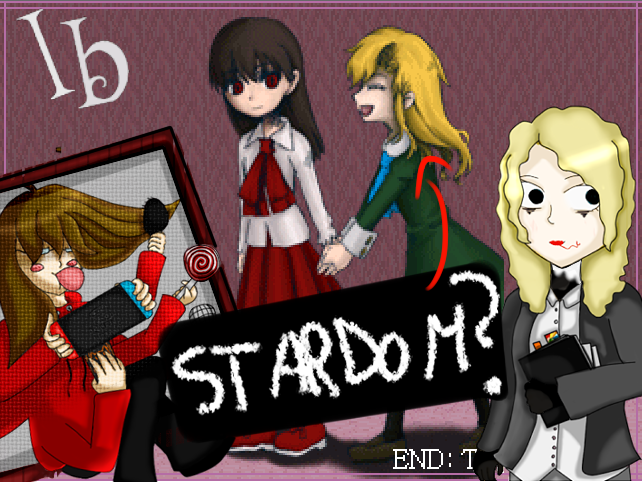
You loved it, it brought you closer than any other game to the HOR-RPG current , a game that has had the most imaginative transpositions by fans in the audiovisual field, school musicals, one billion fan arts and more; broke more than 1,150,000 downloads in Japan only: folks, we’re talking about Ib!
You have no idea of how much thinking about this article has scared us in the past few days. Yes. Because in addition to having to manage the academic commitments and the production of TROFA (we are lonely and sad people, therefore we produce everything by ourselves, forgive us), we already knew that a giant was waiting for us here on the Archives, with which we will open this new season of Back to the future…
A very important piece of HOR-RPG history, something that started to scratch a deep wound inside what was the old definition not only of RPG Horror, but of independent indie horror.
We intended to prepare an interview with kouri who, alas, revealed to us that he did not have enough time for such a project. It would have been very interesting to listen to his version of the facts, since as we will see in the Product History , he would have offered an interesting point of view from an independent author, in fact, who found himself struggling with a fast-coming success that they certainly did not expect to have.
The first release date of this now “masterpiece” of the HOR-RPG field is, compared to others of the genre, rather well known: February 27, 2012. It is unknown to us whether to promote the title Kouri wrote in forums, but it is very likely that the first distribution channels of the game were the author’s website and vector.co.jp, at first glance a portal like others that we have seen here in Back to the Future.
Vector, however, is a truly peculiar distribution channel for an indie game, because the site is not just about video games… But about software in the more general concept (even if it has a special section for games). In fact, if you go to the main page of the site you can find a lot of different products.

A legitimate question may be: “How did people find Ib?” This phenomenon has sparked perplexity in us too.
Realize the situation: even in such a vast portal, the game ranked third in the Vector.jp download record for several years, and won the most consensus (270) in the user voting event “Popular Vote 2012”
It can be said that this title was destined to grow!
Reviews range from four to five stars. Later on here and in the Trump Card paragraph this discussion will be deepened, and above all the reasons for these enthusiastic reviews.
So, for now, let’s see how far the game went from Vector.
It didn’t even have time to switch to other distribution portals, the gameplays on the game were already spreading in Japan.
In addition, the game was so successful that it earned an article on the famous online videogame-news site Famitsu, where Kouri also gave an interview (which we will talk about in the Author-Work Relationship).


(In the photos a part of the article on Ib by Famitsu, and part of the transcript of the interview with Kouri)
And also, as mentioned in the introduction, only in Japan the game gained the most imaginative transpositions from the fans (we believe it is necessary to mention again the case of the school musical based on Ib) and, prick up your ears…
A lot of merchandise (albeit limited to certain periods of time)!
Mini figures sold in “Animated” stores in Japan in early 2014; a calendar for 2013 sold in Comiket 83; Ib, Garry and Mary plushies in late January 2013 at Taito station as arcade awards; a tote bag and a glass sold at the “Guertena Shop”..
The game was therefore increasingly known …
Until it arrived to VgPerson (or Kate, for friends) who came forward to translate Ib into English and bring this small videogame success to us peoples of the West.
Here, after so much popularity in Japan the stage of a great step has approached …
The arrival in the West.
By now, after a full season of Back to the Future, you have learned well what it means to export an HOR-RPG in English … Ib is no exception.
Here too, the game gained good popularity, earning other articles in other online newspapers (some also prominent), as well as obviously a lot of gameplays on Youtube …
But from a wider audience, however, how was the game received (both in the East and in the West)?
Despite being many years later compared to them, the game seems on one hand back from Generation 0, in fact …

The sculptures and paintings in the gallery are truly beautiful. You can enjoy a strange and slightly frightening atmosphere, I recommend this game to those who like these moods. […]
(Review on Vector.com.jp)

(Review on Metacritic.com)
But why we consider Ib a “character drama” then, if it has many elements that can create a good “horror experience”?
We take various excerpts from other reviews regarding the game, including reviews and, this time, comments on Youtube …




“I need to recover… It was a shock, I’m not joking. I’ll be depressed for like a week, like when Akise Aru and Alois Trancy died.”
Here, this last comment is a good reason to start the discussion on a particular ending of Ib, to which the person who wrote refers to: Sacrifice
Over time, when the game gained popularity in the West, two unofficial versions of the game came out: the Green Version and the Hardcore Version.
The Hardcore adds just a few features of the Green Version and precisely increased difficulty with just one petal and no place to heal.
The Green Version is the most particular case (having also been courageous to have been published without Kouri’s consent, and therefore eventually canceled …), because it was characterized by this ending in particular.
This additional ending is based on the choice you have with Mary as to who you would choose if two people could leave the Gallery. In that choice there is the option “I would sacrifice myself”. In this ending Ib actually sacrifices herself, if in this scene (obviously added in this version) the option highlighted on the screen is chosen.

Subsequently Ib tears the petals from her rose, sacrificing herself and making Garry and Mary return to the real world, and as in the final “Forgotten Painting” from the original game…

Here, this slightly tearful ending in the Ib community has made a lot of talk about itself.
But why this?
We saw it in the previous comment: because the characters mainly interact with each other, “the drama is fully concentrated on them” and above all on the nobility of mind of Ib who made her sacrifice in this finale.
In short, there is a more character-centered discourse.
But we will talk more about this phenomenon in the following paragraph …
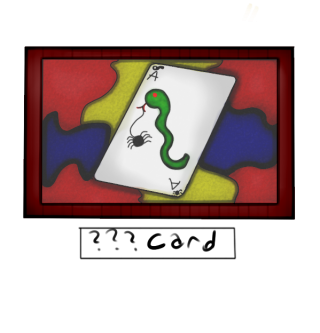
And in fact here I am! Ele has left me place to talk, and here I am, Pao, ready to rack my brains with you!
So, as usual, before we get to the topic, let’s start with a preamble.

Maybe someone will remember this phenomenon …
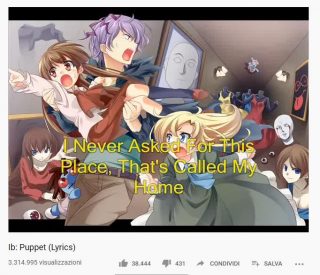

Which then went on in the same period like this…

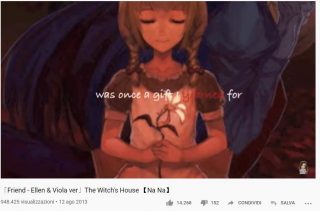
From theories on characterizations, dedicated pages, lyrics of musical pieces that apparently seem to accompany only an effective staging (about the relationship and difference that there can be between a good direction and good characters: it was a theme that we have already covered in Corpse Party), they become the main topic of discussion by fans of these products: the characters.
These youngsters begin to emerge from their contexts of origin, absorbing almost all the attention of the players and spectators who come across their stories.
In fact: they begin to replace the player, there starts to be one of them, the questions asked begin to be “what would X have done instead of Y?”
For this field of games it was an unprecedented turn (always leaving aside the anomalous case of Corpse Party, of course) in which the general public began to ask questions about the “actors on stage”, to create myths.
For this topic I want for a moment to borrow a topic that during my course of study on the history of Hollywood I had the opportunity to address …
“No God please no”.
…Gimme one sec, I’ll grab one thing.
“No no. Why Hollywood…?”
One seeeec.
“No, what does she want to prove? I don’t give a damn that you studied this stuff! “
Found it!

“Wha? What’s this?”
Please, I swear it is useful. It is a book, which is called The Star System by Paul McDonald which I recommend among other things and talks about this phenomenon in the Hollywood industry, very interesting…
“Would you stop?”.
Okay okay, now we’re getting there.
First I should explain to you what the heck is this “star system” and what is meant by the concept of stardom that I will explain shortly. It has to do with the actors, the stars to put it better, and the public.
Try to understand me, this is the era of character drama, isn’t it? What better way to introduce the topic with Ib, since we are talking about it now … Well, in some ways we have started to see this phenomenon in a minimal part, or the bond that is created between spectators and characters, also with Corpse- Party.
In this particular particular time band the phenomenon with HOR-RPG has exploded among fans, perhaps for more multifaceted characterizations (take for example Mary, who has a facade and depending on the contexts shows a different side of her personality), or you want for the creation of real imaginary interactions by fans between the characters of the titles, in this way making them “come out of the frame”, that is, get out of the frame of their narrative contexts to start surviving as “stars” of the current HOR -RPG.
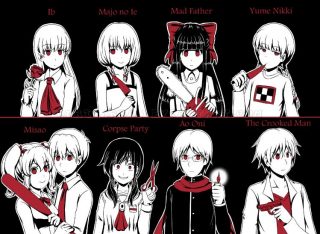


(If you look up “RPG Horror” on Google Images these types of results appear.)
So … Maybe already with this brief introduction you could have understood roughly what kind of topic we are dealing with when we talk about Star System.
In reality there are two terms (Star System and stardom) that reveal a fairly complex industrial apparatus.
It is based on a system that was born with Hollywood but which has not been abandoned today.
Let’s take a few steps back.
So talking about the dawn of Hollywood means first of all taking us to the 1920s, when a new type of industry was taking shape.
The film industry has always been full of risks, in which methods had to be found to be able to compensate for the expenses.
Over time, to sum it up in a nutshell because we are here to talk about HOR-RPG and not, obviously, about the history of cinema, new ways have been tried to create guarantees of earnings, and those guarantees were the stars.
A star stands out from a common actor: it does not lend itself only to staging to perform an action and make an imaginary story true, no, a star brings a face, an attitude, a gesture, a look that the spectators will love.
A look that will continue to be sold, creating a monetary circle influencing the rights to the image even beyond the film itself: interviews, newspaper covers, later with modern marketing methods also gadgets.
Stardom is the myth. In other words, it is an actor’s “portfolio”, of the roles he has played and which contribute to defining their icon in a specific way.
… And maybe you are thinking that all the more reason that here we are talking about real actors, of an industry, which is the cinema industry, which has nothing to do with the context we are analyzing here on the Archives. Agree. You are right because as I said, here we are talking about market systems and methods applied to real people, so obviously it cannot be exactly the same with respect to fantasy characters.
But … There is though. We can find a similar mechanism also in fictional characters, if we want.
Then. I suppose many of the boys and girls who read these articles are passionate, or at least know about anime. What do you say? You say no? Oh yeah?
Why don’t we think, very trivially, of the types of character design that are given to characters destined for these types of products, or a video game that seems to maintain these types of styles and methods of representation? We seek the exaggeration of representation, the extravagance so that the character can become an icon, and obviously not being able to rely on an actor, they throw everything they can do on the character to make it unforgettable in the eyes of the public, and this even before you can see it on stage for the actions it does, it is something that begins with its appearance.
The search for extravagance in the design of the characters that we have, with the advance of a ruthless industry and multiple offers that this type of market offers nowadays, which fortunately for them responds to a very large demand for consumers has led to certain types of pre-established schemes on the one hand to ensure the consent of the spectators, but on the other hand always has to deal with the vast competition and must find a method to ensure a way to emerge and then a loyalty, and here too one of the first methods that you choose as a guarantee of gain is in the characters and in their eccentricities.
Does an example come to mind for what concerns our field of study? Like… This?!

Okay, so back to HOR-RPG: do you know what the difference is? Obviously so far we have talked about well-established industries, a type of working and perceptive environment that the HOR-RPG is not, but which has managed to achieve these types of results albeit in a (almost) completely natural way.
Obviously it will have happened in other types of “fandom born from independent products” of any kind on the Internet, but the point is this: here we are talking about a game-engine like RPG Maker (or its similar competitors in the case of Wolf-RPG Editor), a simple and affordable tool. Really everyone. All it takes is a computer and a lot of willpower to produce a type of product that will never be like … Who knows … A book, which in any case cannot offer such a direct experience to a reader and which constantly requires an effort of imagination , or a short film (speaking at the level of independent productions), in a universe that is the cinematographic one in which to go on alone and as independent authors is truly, truly complex if you don’t have someone to turn to.
Trying to retrace our steps therefore and the main speech Ib before being a game for us is a phenomenon to be analyzed, a complex phenomenon such as Corpse-Party was.
And yet … Maybe I’m forgetting something.
Maybe I’m forgetting the importance of the Gallery in all this: Ib was not remembered only for its characters.
Ib is a truly special, singular case which, like Akemi-tan – of which we discussed in the previous article – rests on the edge of a razor. Here are two videogame cases therefore with a double nature between trying to tell us something and the priority of making us explore a place.
Unlike its main successors such as The Witch’s House and Mad Father, it has perhaps maintained a more balanced relationship with its environment …
Yet there is to think about something.
From the way the Gallery is shown this shows us first of all compared to a character, Weiss Guertena, to whom the names of his works, the dates, the events told about this figure are linked. “Yeah, a character you never see … “you could tell me disappointed, claiming that the Gallery has its own depth and that this name, Weiss Guertena, is quite insignificant. Well it’s true. You never see it.
…That’s the point! The fact that the character never enters the scene is even more important to make room for his environment. Think about it, if we had seen him as a finished and finished character we would have connected the whole story and the emotions felt to him and not to a defined space.
Think about Ellen, Viola and The Witch’s House for example. We like the house we explore, it fascinates us, but after approaching the end, we cannot help making the two girls the beating heart of the game and of our memories connected to it.
The same could be said for Aya and her father in Mad Father.
And here we come to the main talk about the environments of the HOR-RPG, which before were the real ones responsible for making their games unique.
Here everything is concentrated on the figure of a person: the environment changes its identity according to the subject that lives in it, it is no longer as in Yume Nikki where you explored an environment of which you had no concrete clue about the girl who created it and the nature of his dreams (having to open up to free interpretations), and we are not even in Ao Oni or Akemi – Tan in which we explore homes trying to overcome puzzles while escaping from a foreign, external and completely de- contextualized to what the “normality of that environment” would entail. Not even in Corpse-Party, which has had a complex background construction over time, the Heavenly Host has become what it is because of the souls that have given it in its current aspect and with which the characters are constantly confronted.
Always starting from the assumption that without a good starting environment, which is highly personalized or realistic, a good product does not come out. And this is true for classic narration, for anti-narrative schemes, for experimental products and so on, as we have already said all the while talking about Generation 0.
However, something is changing here.
To begin with, it is extravagant and you never know what to expect from the various areas, justifying this choice because it is linked to the “figure of an artist”, and then there are many characters who interact with the player.
This happens until Mary completely takes the space on stage by transporting us to her Album of drawings (speaking of this, not by chance it is an environment that is remembered for Mary precisely, during this final act “the Gallery leaves the scene”) .
In short, the real trump card lies in kouri’s ability, in this very subtle and delicate operation, to have made the space of the staging move hand in hand with the main characters giving it full justice.
Without forgetting the atmosphere of course (with a quote to the suspense created by the doll scene that we have already discussed in the Midnight Train review: “See the famous scene of the giant blue doll in the doll room, there is a construction of remarkable suspense: the key is not found and you have to tear up rag dolls while one of them emerges from the light, accompanied by death bells that only waits for the player to fail. It was a random system by the way: where you had found the key it once wasn’t said you found it the second time.”)
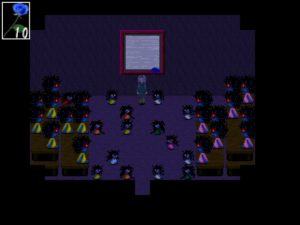
The classification of the areas by colors, the puzzles built in order to offer space and personality to the creatures we meet, the information on the works of art and the recurring enemies such as rag dolls or mannequins and the various Lady are all clues that should make us understand that the Gallery is a character, and this would represent for me the only reason why it is held in high regard today.
Welcome, gentlemen, to the era of character drama.
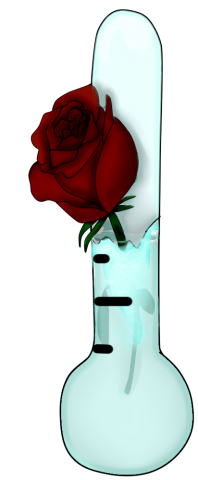 Yes, you have seen clearly: once again we have a thermometer of professionalism low or at least … Which reaches almost half.
Yes, you have seen clearly: once again we have a thermometer of professionalism low or at least … Which reaches almost half.
“These two are annoying…” you are thinking “they don’t like anything.” Those who know us should already know how we think, while for those who instead this on Ib is the first article that reads and interfaces with the heading Back to the Future we invite reading the introduction to understand what are the criteria with which we move in the analysis of the titles of this section…
Even here, we try to be honest and confront our nostalgic feelings: as much as Ib was a subject with a truly remarkable potential if put in the hands of expert producers, this title remained only an authorial draft of a great ” rough project “.
I am saying this because of the defects that we will discuss better in the appropriate section, and perhaps, if you have had the opportunity to read our other articles in the column or the normal reviews, you should know how the relationship with writing is fundamental for the success of a product that works commercially. How?
… Adopting a linguistic code that is as universally recognizable as possible by viewers, with a clear and well-defined main plot.
And of course in the case of a video game we should never forget how this is tied with the gameplay, but this is not a defect that concerns this game.
Let’s go back to the analysis.
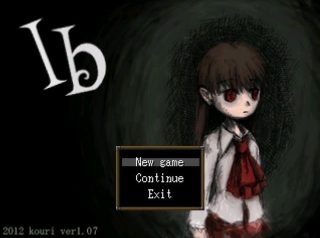
So, before analyzing any stylistic operation: noticed something?
Let’s see if you understand where I want to go considering all the speech we have dealt with before …
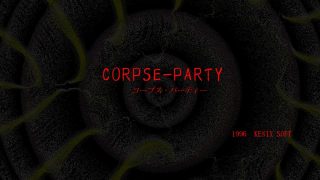
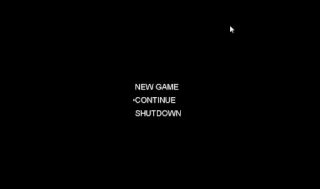
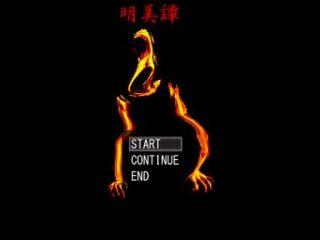
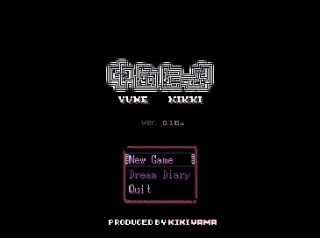
…Yup. Exactly. This is the first to have a character on the screen.
Although it is “sketched” and whose design style is perfectly embodied and confused with the rest of the background (we do not see clean colors or well-defined traits, as in the production of an anime for example) for the first time the HOR-RPG carries a face: not an indefinite background, not a black background, not geometric shapes and not even a monster, but a human face. As will happen from now on for a whole series of HOR-RPG titles present, starting from Mad Father and so on with all the facets…

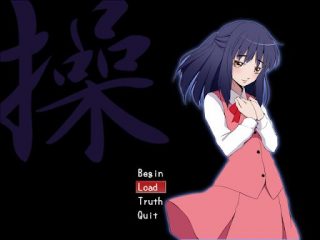
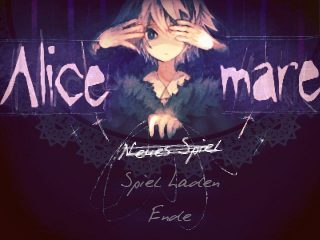

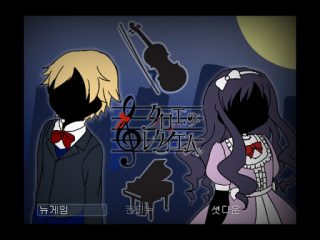

A face that, however, as I mentioned before, blends into the background: it is not put on display in any way within the image, unlike the covers above other titles. The colors are dull, not bright, transmitting a sense of static and quiet.
The style of this game has undoubtedly been appreciated by many users, due to its sophisticated nature and which seems to bring an environment like an art gallery very well on the screen, which already is a new and unusual concept for a horror title , who apparently only needed good skill in managing the gameplay and staging to bring it out.
What makes the title special is the personality shown even in the drawing style.
When you see the icons of the characters apparently it would seem a “sketchy” style of drawing, we had already had an example with the characters of Akemi-Tan (to whom, not being able to place it chronologically, it would also be remembered that he may have been the first to insert protraits drawn “by hand” by the same author with the intention of creating original subjects), yet as sketchy as the lines may seem, they work well in the visual balance with the maps that are explored.
We talked about the role of the music in the Trump Card paragraph, in which we referred to the main themes that certainly contributed to better define the nature of the characters (melancholic melody on the guitar; music box chosen as a stamp for the “lightness / innocence” of the girls and the two different melodies, one slower and the other more lively) and therefore the nature of the game. The ambience OSTs that did their job are not to be forgotten, even if they were mainly selected by free BGM sites.
Here could explain why Ib is a video game that survived the market thanks to external agents, instead of approaches directed by the same author (as instead preferred by his colleagues, Fummy –The Witch’s House– and Sen –Mad Father–, who preferred to work on remakes or light novels or other projects to work on commercial exploitation).
Well, on the page of the kouri site, the author of Ib for those who do not know his name, a special notice is written regarding the reception of emails.

In short they are indications regarding authorizations and permits. This confirms what we introduced at the beginning of the paragraph for the note, namely that the game in the “market” survived alone, thanks to its particular personality.
It has probably already happened to him / her to refuse contracts from producers, perhaps he did not want to stain the nature of the work. Perhaps the background of the Gallery would have been better explained as it happened for Corpse-Party (see the defects paragraph) but at the same time perhaps the characters would have been denaturalized (see the article on Corpse-Party).
In this fairly dated interview, the one we mentioned in the history of the product, we can see how the author has seen their work over time …
― NOTICE: THE INTERVIEW IS IN JAPANESE, IT HAS BEEN TRANSLATED WITH THE TRANSLATOR IN ENGLISH: THE CONCEPTS, HOWEVER, SEEM TO BE UNDERSTANDABLE ―
―What inspired you to make Ib?
kouri Since I had some time in my private life, I decided to try to create a game that I always had the intention of creating. The setting is an art gallery, because it was easier to try to create puzzles and mechanisms.
―How did the production go?
kouri First of all I asked myself this question: “What kind of game do I want to play?” I made that part clear, wrote a basic story, decided the main character and the whole setting and worked on it constantly. The “horror element” and the “mysterious element” were very important in “Ib”, so I thought about these two elements a lot. For the horror part, I simply put “elements that people are afraid of” into the game in a well balanced way, and for the part where the “mystery is solved”, I used the map structure to intertwine the use of works of art in the puzzles and make them interesting. In addition, I made sure that even those who are not good at video games can finish it as serenely as possible.
―What do you think are Ib’s strong points?
kouri I would be really happy that if the players felt the eerie atmosphere of the museum, and I also worked a lot on the sprites.
―How was the reaction of the users who played Ib?
kouri I am really happy to have received a generally positive reception in many parts of the world especially from the point of view of the characters: this convinced me to work every day on the subsequent versions of the game
―Finally, say one last sentence to the community.
kouri Thanks for playing Ib! Even if you haven’t done it yet, Ib is free so if you have time, please try it. It’s not very difficult, you can play it safely. I’d be happy to know if you liked it when you finished it.
So here too we are faced with a phenomenon that has characterized Generation 0 for a long time: the carefree approach with HOR-RPG video games. Both from the public and from the players themselves, the times in which they tried new games and looked at productions with an experimental approach, environments that although niche managed in exceptional cases to reach the attention even of non-players.
This is the key to why the thermometer line with professionalism is so low for a game like this.
An innovative game of its kind but which is still anchored to the exploratory and experiential approaches for which its predecessors have distinguished themselves.
What is interesting to note in this interview is how one thing was stated: kouri already knew where he wanted to go. He first chose the context (i.e. the predominant environment) and then the genre. Choosing a genre in advance, or horror in this context, already means choosing a certain type of linguistic code. Probably the question that arose was: how can I make a museum unsettling?
Knowing where you want to go right from the start is one of the tips that professionals in the creative and audiovisual sector give and is often the key to working with quality products. Despite this, it can also be seen how he / she declared that he / she thought about the plot afterwards, and this can be seen in the final result …
… Which we will talk about shortly.
Finally, here we are. This is a sore point every time … Yeah …
So yes. The defects of Ib.
Let’s also say that as far as the positive aspects are concerned, we have only reached the same conclusions that many of us have arrived before, namely that the exploratory experience offered by the museum and the way of representing it have laid important foundations for the immense success of the title: that’s the trunk, the backbone of the game, let’s not forget that the two characters, Garry and Mary appear very late and you can interact and get more excited atmospheres only later. Above all the latter, which could be said to be useful only to close the narrative circle during the final acts.
So the point is to understand instead what is it that didn’t work.
Well, we could say that from the simple respect of the internal rules of this world, the world of the Gallery, there is something wrong.
I could start by talking about the rule of damaging paintings: many complaints for a lit lighter…
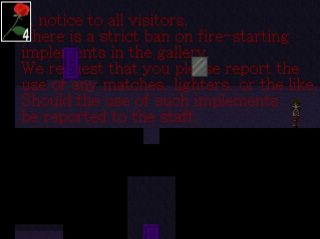
… And then when Mary’s picture was burned there didn’t seem to be any kind of repercussion.
Not to mention the myriad of information we don’t have about this place, namely: who wrote the two-person rule? Why? How does the relationship between the two worlds work? Why is the Gallery now “unattended”? How did Mary gain this sort of leadership among other art pieces? Why, about the latter, some attack the protagonists and others do not?
… And don’t try to find justification by some random theory because it is information that is not given to us in any way during the game. Yes, interacting with every possible object.
Maybe I’m exaggerating, maybe for some of these questions the answers are there because it was enough to read the descriptions of the works well, however most of the background of this “Fabricated World” remains in mystery and is ignored. It is so “because it is like this”, we have to imagine the rules.
Now you understand well how to make a certain background incomplete after certain types of information have been reported is complicated when you decide to try to bring a product to a more demanding level of narration.
I will repeat a phrase that I have already said in this article: in some ways it is not “different” from Akemi-Tan, both are on the edge. If the game had left a little more information, it probably would have betrayed itself and would have had to face a series of contradictions that would have broken the very thin balance on which the main plot was built (Ib and Garry want to leave the Gallery, Mary doesn’t want to – exposure of the conflict, final acts) and on which the award-winning atmospheres of the game were based.
A question may now arise spontaneously is …
Why Akemi-Tan, which has the same type of writing defect (especially the lack of a solid background) but which still maintains a state of very high tension, has not been taken into consideration as was Ib?
The answer has been brought up quite often in this article.
As I said before: there we were simply exploring haunted houses, probably the players and spectators did not care about investigating Akemi’s past: solved the problem of the curse, solved everything, we are satisfied with it. The lack of background on Akemi seems to have weighed little on the players: there was only an imbalance between one part of the game and the other with total change of atmosphere.
In Ib … There aren’t only the characters. In Ib there is the Gallery which becomes the main actor of the game and proposes certain rules.
Having said that, how do we put it? We take this game as it is?
…Drumroll…
Our answer can only be positive. This character drama is a very complicated branch of HOR-RPG history to observe, in which it takes just a few months to notice the abysmal changes in the relationship between exploration / gameplay and story-telling.
We have just entered the Golden Age, an age in which new rules begin to be defined and written for the creation of a Horror RPG that even the authors of today in some aspects don’t seem to want to give up, a period in which the HOR-RPG doesn’t know how what it is. It is not only an independent product, but it certainly is not even a commercial product produced by professionals.
They are not experimental titles, everyone wants to conquer their own identity, yet the various fans cannot associate the faces and names of those who produced these works, who prefer to remain as “hidden individuals”.
The characters begin to be seen as “stars”, as happens in the audiovisual and videogame products launched by the production companies, but on the other side it is very difficult to imagine their complete backgrounds, this until you will always define a type of writing more articulated.
So with our time machine we have just entered an era of vivid transformation! You will realize this for yourself: each title will be very different from the other by adding new features and rules for the definition of the HOR-RPG current that we are studying, this starting from the arrangement of narrative information proposed by The Witch’s House, that we will meet next time…

L’avete amato, vi ha avvicinato più di ogni altro gioco alla corrente HOR-RPG, un gioco tra quelli che più ha avuto trasposizioni fantasiose da parte dei fan in ambito audiovisivo, di musical scolastici, mille-mila fan art e quant’altro; ha rotto più di 1.150.000 download solo in Giappone: gente, stiamo parlando di Ib!
Non potreste avere l’idea di quanto pensare a questo articolo ci abbia spaventato negli ultimi giorni. Sì. Perché oltre a dover gestire gli impegni accademici e la produzione di TROFA (siamo persone sole e tristi, perciò da sole ci produciamo tutto, perdonateci), sapevamo già che ci aspettava un colosso qui sugli Archives, con cui apriremo questa nuova stagione della rubrica Ritorno al futuro…
Un pezzo molto importante di storia degli HOR-RPG, un qualcosa che ha iniziato a scalfire una ferita profonda all’interno di quella che era la vecchia definizione non solo di RPG Horror, ma di horror indie indipendente.
Avevamo intenzione di preparare un intervista con kouri che, ahimè, ci ha rivelato di non aver abbastanza tempo per un progetto del genere. Sarebbe stato molto interessante ascoltare la sua versione dei fatti, poiché come vedremo nella Storia del prodotto, avrebbe offerto un interessante punto di vista da parte di un autore indipendente, per l’appunto, che si è trovato da un giorno all’altro alle prese con un successo che sicuramente non si aspettava di avere.
La prima data di uscita di questo ormai “masterpiece” del campo HOR-RPG è, rispetto ad altri del genere, piuttosto nota: 27 febbraio 2012. Ci è sconosciuto se per promuovere il titolo Kouri abbia scritto in dei forum, ma è molto probabile che i primi canali di distribuzione del gioco siano stati il sito dell’autore e vector.co.jp, a primo attrito un portale come altri che abbiamo visto qui in Ritorno Al Futuro.
Vector però è un canale di distribuzione davvero peculiare per un gioco indie, perché il sito non tratta solo di videogiochi… Bensì di software nel concetto più generale (anche se ha una sezione apposita per i giochi). Se si va nella pagina principale del sito infatti si può trovare di tutto.

Una domanda legittima può essere: “Come faceva la gente a trovare Ib?”Questo fenomeno ha scatenato perplessità anche in noi, in effetti.
Rendetevi conto della situazione: anche in un portale tanto vasto, il gioco si è classificato terzo nel record di download di Vector.jp per diversi anni, e ha vinto il maggior numero di consensi (270) nell’evento di voto degli utenti “Popular Vote 2012”.
Si può dire che questo titolo era destinato a crescere!
Le recensioni vanno dalle quattro alle cinque stelle. Più tardi qui e nel paragrafo Asso Nella Manica si approfondirà questo discorso, e soprattutto le motivazioni di queste recensioni tanto entusiastiche.
Quindi, per adesso, vediamo com’è andato avanti il gioco da Vector.
Non ha avuto neanche il tempo di passare ad altri portali di distribuzione, che i gameplay sul titolo già spopolavano in Giappone.
Inoltre, il gioco fece così tanto successo che si guadagnò un articolo sul famoso sito di giornalismo videoludico Famitsu, a cui Kouri ha rilasciato anche un’intervista (di cui parleremo nel Rapporto Autore-Opera).


(Nelle foto una parte dell’articolo su Ib di Famitsu, e parte della trascrizione dell’intervista a Kouri)
E inoltre, come detto nell’introduzione, solo in Giappone il gioco si guadagnò le trasposizioni più fantasiose da parte dei fan (riteniamo necessario citare ancora il caso del musical scolastico basato su Ib) e, una bella novità…
Un bel po’ di merchandise (seppur limitato a certi periodi di tempo)!
Mini figure vendute nei negozi “Animate” inGiappone all’inizio del 2014; un calendario per il 2013 venduto a Comiket 83; peluche di Ib, Garry e Mary verso la fine di gennaio 2013 alla stazione di Taito come premi agli arcade; una tote bag e un bicchiere venduti al “Guertena Shop”.
Il gioco quindi fu sempre più conosciuto…
Fino ad arrivare a VgPerson (o Kate, per gli amici) che si fece avanti per tradurre Ib in inglese e portare questo piccolo successo videoludico a noi popoli dell’Ovest.
Ecco, dopo tanta popolarità in Giappone si è avvicinata la tappa di un gran passo…
L’arrivo in Occidente.
Ormai, dopo una stagione di Ritorno Al Futuro, avrete imparato bene cosa vuol dire esportare un HOR-RPG in inglese… Ib non fa eccezione.
Anche qui da noi il gioco ottenne una buona popolarità, guadagnandosi altri articoli in altre testate online (alcune anche di spicco), oltre a ovviamente mille-mila gameplay su Youtube…
Ma da un pubblico più “largo”, invece, come è stato recepito il gioco (sia in Oriente, sia in Occidente)?
Pur essendo di molti anni dopo rispetto ad essi, il gioco sembra da una parte reduce dalla Generazione 0, infatti…

Le sculture e i dipinti nella Galleria sono davvero belli. Si può godere di un’atmosfera strana e leggermente spaventosa, raccomando questo gioco a chi piacciono questi mood.[…]
(Recensione su Vector.com.jp)

“Gioco bellissimo – probabilmente uno dei miei giochi horror-pixel preferiti. A primo attrito non potrebbe sembrare chissà che, ma ha una grande personalità. L’atmosfera di questo gioco ti trascina così tanto che ho trovato difficile il non essere risucchiato negli ambienti e spaventarmi io stesso/a. Non è molto lungo, ma ha tanto nel breve tempo che ci passi.”
(Recensione da Metacritic, da parte del pubblico)
Ma perché Ib noi lo consideriamo “character drama” allora, se ha molti elementi che possono creare una buona “horror experience”?
Prendiamo vari spezzoni di altri giudizi nei confronti del gioco, tra recensioni e, stavolta, commenti su Youtube…

“Non ci sono immagini particolarmente macabre, solo storia e pura amicizia. La storia è ben raccontata”

“Garry è diventato facilmente il mio personaggio videoludico preferito”

“Mary rimarrà sempre la mia preferita. Ricordiamo che ha perso suo ‘padre’… Vuole solo che Ib sia sua amica. Garry sembra il suo creatore e ciò la fa arrabbiare.”
Ecco, quest’ultimo commento è un buon motivo per iniziare il discorso su un finale particolare di Ib, a cui si riferisce la persona che ha scritto: Sacrifice.
Nel corso del tempo, quando il gioco guadagnava popolarità in Occidente, uscirono due versioni non ufficiali del gioco: la Green Version e la Hardcore Version.
La Hardcore aggiunge solo alcune caratteristiche della Green Version e appunto difficoltà aumentata con solo un petalo e nessun punto dove curarsi.
La Green Version è il caso più particolare (essendo anche stata coraggiosa ad essere stata pubblicata senza il consenso di Kouri, e quindi alla fine cancellata…), perché è stata caratterizzata da questo finale in particolare.
Praticamente questa ending aggiuntiva è basata sulla scelta che hai con Mary sul chi sceglieresti se potessero uscire due persone dalla Galleria. In quella scelta c’è l’opzione “Mi sacrificherei”. In questo finale effettivamente Ib si sacrifica, se in questa scena (aggiunta ovviamente in questa versione) si sceglie l’opzione evidenziata nello screen.

Successivamente Ib strappa i petali dalla propria rosa, appunto sacrificandosi e facendo tornare Garry e Mary nel mondo reale, e come nel finale “Dipinto Dimenticato” dal gioco originale…

Ecco, questo finale un po’ strappalacrime nella community di Ib ha fatto molto parlare di sé.
Ma perché ciò?
L’abbiamo visto nel commento di prima: perché interagiscono principalmente i personaggi tra loro, “il dramma è concentrato pienamente su di loro” e soprattutto sulla nobiltà d’animo di Ib che in questo finale l’ha fatta sacrificare.
In breve, c’è un discorso più incentrato sui personaggi.
Ma parleremo meglio di questo fenomeno nel paragrafo seguente…
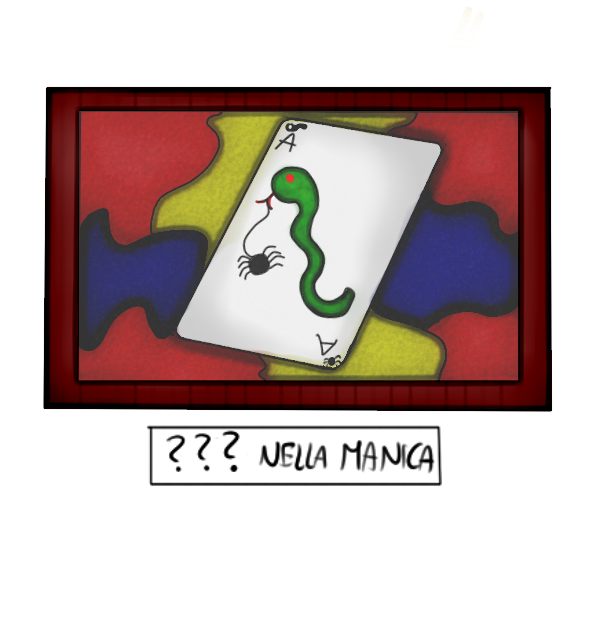
Ed infatti eccomi qui! Ele mi ha ceduto il posto, ed eccomi qui, Pao, pronta a scervellarsi assieme a voi!
Dunque, come mio solito prima di arrivare all’argomento partiamo da un preambolo.

Forse qualcuno si ricorderà di questo fenomeno…


Che poi nello stesso periodo è andato avanti così…


Da teorie sulle caratterizzazioni, pagine dedicate, lyrics dei brani musicali che apparentemente sembrano accompagnare solo un’efficace messinscena (a proposito del rapporto e differenza che ci può essere tra una buona regia e buoni personaggi: è stata una tematica che abbiamo già trattato in Corpse Party), loro diventano il principale oggetto di discussione da parte dei fan di questi prodotti: i personaggi.
Questi giovincelli cominciano ad emergere dai loro contesti di provenienza, assorbendo quasi tutta l’attenzione dei giocatori e spettatori che si imbattono nelle loro vicende.
Per l’appunto: cominciano a sostituirsi al giocatore, comincia a esserci un loro, le domande poste iniziano ad essere “cosa avrebbe fatto X al posto di Y?”
Per questo campo di giochi si è trattato di una svolta senza precedenti (sempre tralasciando il caso anomalo di Corpse Party, si intende) in cui il grande pubblico ha cominciato a porsi delle domande sugli “attori in scena”, a crearsi dei miti.
Per questo argomento voglio per un attimo prendere in prestito un argomento che durante il mio percorso di studi sulla storia di Hollywood ho avuto modo di affrontare…
“No no ti prego no”.
…Un momento eh, che prendo una cosa.
“No no. Che cavolo c’entra Hollywood?”
Un momento.
“No che vorrebbe dimostrare questa qui ora? Non me frega nulla che hai studiato sta roba!”
Trovato!

“Embè? Che è ‘sta roba?”
Vi prego, vi giuro che è utile. È un libro, che si chiama appunto The Star System di Paul McDonald che vi consiglio tra l’altro e parla di questo fenomeno nell’industria hollywoodiana, molto interessante…
“Oh e basta”.
Okay okay, ora ci arrivo.
Prima dovrei spiegarvi che cappero è questo “star system” e cosa si intende per concetto di stardom che vi spiegherò tra poco. Ha a che fare con gli attori, le star per meglio dire, e il pubblico.
Cercate di capirmi, questa è l’epoca dei character drama, no? Quale migliore modo di introdurre l’argomento con Ib, visto che ne stiamo parlando ora…Beh, per certi versi abbiamo iniziato a vedere in minima parte questo fenomeno, ovvero il legame che si crea tra spettatori e personaggi, anche con Corpse-Party.
In questa particolare fascia temporale particolare il fenomeno con gli HOR-RPG è esploso tra gli appassionati, vuoi forse per delle caratterizzazioni più sfaccettate (prendete ad esempio Mary, che ha una facciata e a seconda dei contesti mostra un lato diverso della sua personalità), o vuoi per la creazione di vere e proprie interazioni immaginarie da parte dei fan tra i personaggi del titoli, in questo modo facendoli “uscire fuori dal frame”, ovvero uscire dalla cornice dei loro contesti narrativi per iniziare a sopravvivere come “divi” della corrente HOR-RPG.



(Già cercando RPG Horror su Google Immagini appaiono questi tipi di risultati.)
Dunque…Forse già con questa breve introduzione avrete potuto capire grosso modo che tipo di argomento stiamo affrontando quando parliamo di Star System.
In realtà sono due termini (Star System e stardom) che rivelano un apparato industriale abbastanza complesso.
Si basa su un sistema appunto, nato con Hollywood ma che oggi non è stato abbandonato, anzi.
Facciamo un attimo qualche passo indietro.
Quindi, parlare degli albori di Hollywood vuol dire innanzitutto portarci negli anni ’20, in cui si stava configurando un nuovo tipo di industria.
L’industria del cinema è sempre stata piena di rischi, in cui bisognava trovare dei metodi per poter compensare, con i guadagni, le spese effettuate.
Con il tempo, per riassumervela in soldoni perché siamo qui per parlare di HOR-RPG e non, giustamente, di storia del cinema, si sono sperimentati nuovi modi per creare delle garanzie di guadagno, e quelle garanzie erano le star.
Una star si distingue da un comune attore: non si presta solo alla messa in scena per compiere un’azione e rendere vera una storia immaginaria, no, una star porta un volto, un atteggiamento, un gesto tutto suo, uno sguardo che gli spettatori ameranno.
Uno sguardo che continuerà ad essere venduto, creando un circolo monetario influente sui diritti all’immagine anche aldilà del film stesso: interviste, copertine di giornali, in seguito con i moderni metodi di marketing anche gadgets.
Lo stardom è il mito. In altre parole è il “portfolio” di un attore, dei ruoli che ha fatto e che contribuiscono a circoscrivere in maniera ben determinata la sua icona.
…E magari starete pensando che a maggior ragione che qui si parla di attori veri, di un’industria, che è quella del cinema, che non ha nulla a che vedere con il contesto che stiamo analizzando qui sugli Archives. D’accordo. Avete ragione perché come vi dicevo anch’io, qui si parla di sistemi e metodi di mercato applicato su persone reali, quindi ovviamente non può essere esattamente la stessa cosa nei confronti dei personaggi di fantasia.
Però…C’è un però. Possiamo trovare un meccanismo simile anche nei personaggi di finzione, se vogliamo.
Allora. Suppongo che molti dei ragazzi e ragazze che leggono questi articoli siano degli appassionati, o per lo meno conoscano gli anime. Cosa dite se ve li tiro in ballo? Ah sì? Dite di no?
Perché non pensiamo, molto banalmente, ai tipi di character design che si danno a dei personaggi destinati a questi tipi di prodotti, o un videogioco che sembra mantenere questi tipi di stili e metodi di rappresentazione. Si cerca l’esagerazione di rappresentazione, la stravaganza così ché il personaggio possa diventare un’icona, e non potendo ovviamente affidarsi ad un attore, buttano tutto quanto si possa fare sul personaggio per renderlo indimenticabile agli occhi del pubblico, e questo prima ancora che si possa vedere in scena per le azioni che compie, è qualcosa che comincia dalla sua apparenza.
La ricerca della stravaganza nel design dei personaggi che assumono, con l’avanzare di un’industria spietata e molteplici offerte che offre questo tipo di mercato al giorno d’oggi a cui per loro fortuna risponde una domanda molto vasta di consumatori ha portato a certi tipi di schemi prestabiliti da un lato per assicurarsi il consenso degli spettatori, ma dall’altra ha sempre da fare i conti con la vasta concorrenza e deve trovare un metodo per garantirsi un modo di emergere e poi una fidelizzazione, e anche qui uno dei primi metodi che si sceglie come garanzia di guadagno è nei personaggi e nelle loro eccentricità.
Vi viene in mente forse un esempio per quello che riguarda il nostro campo di studi? Tipo questo?!

Okay, quindi, tornando agli HOR-RPG: sapete qual è la differenza? Che ovviamente finora abbiamo parlato di industrie ben consolidate, un tipo di ambiente lavorativo e percettivo che l’HOR-RPG non è, ma che è riuscito a raggiungere seppur in minima parte questi tipi di risultati in maniera (quasi) del tutto naturale.
Ovvio che sarà capitato anche in altri tipi di “fandom nati da prodotti indipendenti” di qualsiasi tipo su Internet, ma il punto è questo: qui stiamo parlando di un game-engine come RPG Maker (o suoi simili concorrenti nel caso di Wolf-RPG Editor), uno strumento semplice e alla portata di tutti. Davvero di tutti. Basta solo un computer e tanta forza di volontà per produrre un tipo di prodotto che non sarà mai come…Chessò…Un libro, che non può in ogni caso offrire un’esperienza così diretta ad un lettore e che richiede costantemente uno sforzo d’immaginazione, o un cortometraggio (parlando a livello di produzioni indipendenti), in un universo che è quello cinematografico in cui andare avanti da soli e come autori indipendenti è veramente, veramente complesso se non si ha qualcuno a cui rivolgersi.
Cercando di tornare sui nostri passi quindi e sul discorso principale Ib prima di essere un gioco per noi è un fenomeno da analizzare, un fenomeno complesso come lo è stato Corpse-Party.
Eppure… Forse sto dimenticando qualcosa.
Forse sto dimenticando l’importanza della Galleria in tutto questo: Ib non è stato ricordato solo per i suoi personaggi.
Ib è un caso davvero particolare, singolare, che come Akemi-tan -di cui abbiamo discusso nell’articolo precedente- si appoggia sul filo di un rasoio. Ecco due casi videoludici quindi dalla doppia natura tra tentativo di raccontarci qualcosa e la priorità di farci esplorare un luogo.
A differenza dei suoi successori principali quali The Witch’s House e Mad Father, ha forse mantenuto un rapporto più equilibrato con il suo ambiente…
Eppure c’è da riflettere su una cosa.
Dal modo in cui la Galleria viene mostrata questa si mostra a noi prima di tutto rapportata a un personaggio, Weiss Guertena, a cui sono legati i nomi delle sue opere, le date, gli avvenimenti raccontati su questa figura.“Certo, un personaggio che non si vede mai…” potreste dirmi delusi, sostenendo che la Galleria ha un proprio spessore e che questo nome, Weiss Guertena, sia abbastanza insignificante. Beh, è vero. Non si vede mai.
…È questo il punto! Il fatto che il personaggio non entri mai in scena è ancora più importante per lasciare spazio al suo ambiente. Pensateci, se l’avessimo visto come personaggio fatto e finito avremmo collegato tutta la storia e le emozioni provate a lui e non ad uno spazio definito.
Pensate a Ellen, Viola e The Witch’s House ad esempio. La casa che esploriamo ci piace, ci affascina, ma dopo esserci approcciati al finale non possiamo fare a meno di rendere le due ragazze il cuore pulsante del gioco e dei nostri ricordi ad esso collegati.
Stesso discorso si potrebbe fare per Aya e suo padre in Mad Father.
E qui arriviamo al discorso principale a proposito degli ambienti degli HOR-RPG, che prima erano i veri responsabili nel rendere i loro giochi unici.
Qui tutto è concentrato sulla figura di una persona: l’ambiente muta la sua identità a seconda del soggetto che la abita, non è più come in Yume Nikki dove esploravi un ambiente di cui non avevi alcun indizio concreto sulla ragazzina che l’ha creato e la natura dei suoi sogni (dovendo per forza aprirsi alle libere interpretazioni), e nemmeno siamo in Ao Oni o Akemi – Tan in cui si esplorano delle abitazioni cercando di superare puzzles mentre si fugge da un mostro estraneo, esterno e del tutto de-contestualizzato a quello che comporterebbe la “normalità di quell’ambiente”. Nemmeno in Corpse-Party, che pur ha avuto una complessa costruzione di background col tempo, la Heavenly Host è diventata ciò che è per via delle anime che le hanno conferito in suo aspetto attuale e con cui i personaggi si confrontano in continuazione.
Sempre partendo dal presupposto che senza un buon ambiente di partenza, che sia fortemente personalizzato o realistico, un buon prodotto non viene fuori. E questo vale per la narrazione classica, per schemi anti-narrativi, per prodotti sperimentali e via dicendo, come abbiamo già detto per tutto il tempo parlando della Generazione 0.
Tuttavia, qui sta cambiando qualcosa.
Tanto per cominciare è stravagante e non sai mai cosa aspettarti dalle varie aree, giustificando questa scelta poiché si lega alla “figura di un artista”, e poi sono presenti numerosissimi personaggi che interagiscono con il giocatore.
Questo avviene finché Mary non prende completamente lo spazio in scena trasportandoci nel suo Album dei disegni (a proposito di questo, non a caso si tratta di un ambiente che si ricorda per Mary appunto, durante questo atto conclusivo “la Galleria esce di scena”).
In breve il vero asso nella manica sta nella capacità di kouri, in questa sottilissima e delicatissima operazione, di aver fatto muovere lo spazio della messinscena al pari passo con i personaggi principali dandogli così piena giustizia.
Senza dimenticare delle atmosfere ovviamente (con una citazione alla suspence creata dalla scena delle bambole che abbiamo già discusso nella recensione di Midnigh Train: “Vedi la famosa scena della bambola blu gigante nella stanza della bambole, lì c’è una costruzione della suspence notevole: la chiave non si trova e devi squartare bambole di pezza mentre una di queste emerge dalla luce, accompagnata da campane di morte che aspetta solo che il giocatore fallisca. Era un sistema random tra l’altro: dove avevi trovato la chiave una volta non era detto che la trovavi la seconda volta.”)

La classificazione delle aree per colori, gli enigmi costruiti al fine di offrire spazio e personalità alle creature che si incontrano, le informazioni sulle opere d’arte e i nemici ricorrenti come le bamboline di pezza o i manichini e le varie Lady sono tutti indizi che dovrebbero farci comprendere che la Galleria stessa comincia ad essere un personaggio, e questo rappresenterebbe per me l’unico motivo per cui essa è tenuta in alta considerazione tutt’oggi.
Benvenuti, signori, nell’epoca dei character drama.
 Già, avete visto bene: ancora una volta abbiamo un termometro della professionalità basso o almeno…Che raggiunge quasi la metà.
Già, avete visto bene: ancora una volta abbiamo un termometro della professionalità basso o almeno…Che raggiunge quasi la metà.
“Queste hanno rotto il…” starete pensando “non gli va bene davvero niente”.Chi ci conosce dovrebbe sapere già come ragioniamo, mentre per chi invece questo su Ib è il primo articolo che legge e si interfaccia con la rubrica Ritorno Al Futuro invitiamo alla lettura dell’introduzione per capire quali sono i criteri con cui ci muoviamo nell’analisi dei titoli di questa rubrica…
Per il resto, anche qui, cerchiamo di essere onesti e confrontarci con i nostri sentimenti nostalgici: per quanto Ib fosse un soggetto con un potenziale davvero notevole se messo nelle mani di produttori esperti, questo titolo è rimasto solo una bozza autoriale di un grande “progetto grezzo”.
Sto dicendo questo per via dei difetti dell’opera di cui parleremo meglio nella sezione apposita, e forse, sempre se avete avuto modo di leggere altri nostri articoli della rubrica o delle normali recensioni, dovreste sapere quanto il rapporto con la scrittura sia fondamentale per la buona riuscita di un prodotto che funzioni sul piano commerciale. Come?
…Adottando un codice linguistico che sia il più possibile riconoscibile a livello universale dagli spettatori, con una main plot chiara e ben definita.
Ed ovviamente nel caso di un videogioco non c’è mai da dimenticare come questa viene districata con il gameplay, ma questo non è un difetto che riguarda quest’opera.
Torniamo all’analisi.

Dunque, prima di fare qualsiasi operazione sul piano stilistico: notate una cosa?
Vediamo se capite dove voglio andare a parare considerando tutto il discorso che abbiamo affrontato prima…




…Sì. Esattamente. Questo è il primo ad avere sullo schermo un personaggio, appunto.
Per quanto sia “abbozzato” e il cui stile di disegno si incarna e confonde alla perfezione con il resto dello sfondo (non vediamo infatti mica dei colori puliti o tratti ben definiti, come nella produzione di un anime ad esempio) per la prima volta l’HOR-RPG porta un volto: non uno sfondo indefinito, non uno sfondo nero, non delle forme geometriche e nemmeno un mostro, ma un viso umano. Come succederà da adesso in poi per tutta una serie di titoli HOR-RPG presenti, a partire da Mad Father e via dicendo con tutte le sfaccettature del caso…






Un viso che tuttavia, come ho accennato prima, si mimetizza con lo sfondo: non viene messo in mostra in alcun modo all’interno dell’immagine, a differenza delle copertine qui sopra di altri titoli. I colori sono spenti, non luminosi, trasmettendo un senso di staticità e quiete.
Lo stile di questo gioco è stato indubbiamente apprezzato da tanti utenti, per via della sua natura sofisticata e che sembra portare molto bene sullo schermo un ambiente come una galleria d’arte, che già da sé è un concept nuovo e insolito per un titolo horror, a cui a quanto pare serviva solo una buona maestria nella gestione del gameplay e della messa in scena per farlo emergere.
Ciò che rende il titolo particolare è la personalità mostrata perfino nello stile di disegno.
Quando si vedono le icone dei personaggi apparentemente sembrerebbe uno stile di disegno sporco, avevamo già avuto un esempio con i personaggi di Akemi-Tan (cui, non potendolo collocare cronologicamente, ci sarebbe anche da ricordare che potrebbe essere stato il primo ad inserire dei protraits disegnati “a mano” dallo stesso autore con l’intento di creare soggetti originali), eppure per quanto le linee possano sembrare sporche funzionano bene nell’equilibrio visivo con le mappe che si esplorano.
Sul ruolo delle musiche ne abbiamo parlato in Asso nella manica, in cui facevamo riferimento alle main theme che hanno certamente contribuito a definire meglio la natura dei personaggi (melodia malinconica alla chitarra; carillon scelto come timbro per la “leggerezza/innocenza” delle bambine e le due diverse melodie, una più lenta e l’altra più vivace) e quindi la natura del gioco. Non sono da dimenticare le ambience che hanno fatto il loro lavoro, anche se sono state principalmente selezionate da siti di BGM gratuiti.
Qui potrebbe spiegarsi il perché Ib è un videogioco che è sopravvissuto nel mercato grazie a degli agenti esterni, invece che approcci diretti dallo stesso autore (come invece hanno preferito fare i suoi colleghi, Fummy –The Witch’s House– e Sen –Mad Father–, che hanno preferito lavorare su remake o light novel o altri progetti per lavorare sulla sfruttabilità commerciale).
Ebbene, nella pagina del sito di kouri, l’autor* di Ib per l’appunto per chi non conoscesse il suo nome, è scritto un avviso particolare riguardo la ricezione delle mail.

In breve sono delle indicazioni riguardo autorizzazioni e permessi. Questo è a conferma di quanto abbiamo introdotto a inizio paragrafo per l’appunto, vale a dire che il gioco nel “mercato” è sopravvissuto da solo, grazie alla sua particolare personalità.
Probabilmente già gli/le sarà capitato di rifiutare dei contratti da parte di produttori, forse non voleva macchiare la natura dell’opera. Forse si sarebbe spiegato meglio il background della Galleria come è successo per Corpse-Party (vedere il paragrafo dei Difetti dell’opera) ma allo stesso tempo forse i personaggi sarebbero stati denaturalizzati (vedere l’articolo su Corpse-Party).
In questa intervista abbastanza datata, quella che avevamo citato in Storia del prodotto, possiamo notare come l’autor* abbia visto la sua opera nel corso del tempo…
―AVVISO: L’INTERVISTA E’ IN GIAPPONESE, E’ STATA TRADOTTA CON IL TRADUTTORE IN INGLESE ED INFINE PASSATA IN ITALIANO: I CONCETTI PERO’ SEMBRANO ESSERE COMPRENSIBILI―
―Cosa ti ha ispirato a produrre Ib?
kouri Dato che nella mia vita privata avevo un po’ di tempo, ho deciso di provare a creare un gioco che avevo sempre avuto l’intenzione di creare. L’ambientazione è una galleria d’arte, perchè era più facile provare a creare enigmi e meccanismi.
―Com’è andata avanti la produzione di Ib?
kouri Prima di tutto mi sono fatt* questa domanda: “Che tipo di gioco voglio fare?” ho messo in chiaro quella parte, scritto una storia di base, deciso il personaggio principale e tutto il setting e ci lavoravo costantemente. L'”elemento horror” e l'”elemento misterioso” erano molto importanti in “Ib”, quindi ho pensato molto a questi due elementi. Per la parte horror, ho semplicemente messo “elementi di cui la gente ha paura” nel gioco in modo ben bilanciato, e per la parte in cui si “risolve il mistero”, ho usato la struttura della mappa per intrecciare l’utilizzo di opere d’arte negli enigmi e renderli interessanti. Inoltre, ho fatto in modo che anche chi non è bravo nei videogiochi possa finirlo il più serenamente possibile.
―Quali pensi che siano I punti forti di Ib?
kouri Sarei davvero felice che se I giocatori hanno sentito l’atmosfera inquietante del museo, e ho anche lavorato molto sulle sprite.
―Come è stata la reazione degli utenti che hanno giocato Ib?
kouri Sono davvero felice di aver ricevuto una ricezione in generale positiva in molte parti del mondo soprattutto dal punto di vista dei personaggi: ciò mi ha convinto a lavorare ogni giorno sulle versioni successive del gioco
―Infine, dì un’ultima frase alla community.
kouri Grazie per aver giocato Ib! Anche se non l’hai ancora fatto, Ib è gratuito quindi se hai tempo, per favore provalo. Non è molto difficile, si fa giocare tranquillamente. Sarei felice di sapere se ti è piaciuto quando l’hai finito.
Quindi anche qui ci troviamo davanti a un fenomeno che ha caratterizzato a lungo la Generazione 0: l’approccio spensierato con i videogiochi HOR-RPG. Sia da parte del pubblico che dai giocatori stessi, i tempi in cui si provavano giochi nuovi e si guardava alle produzioni con approccio sperimentale, ambienti che seppur di nicchia riuscivano in casi eccezionali a raggiungere l’attenzione anche dei non-giocatori.
Questa è la chiave per cui la linea del termometro con la professionalità è così basso per un gioco come questo.
Un gioco innovativo nel suo genere ma che è ancora ancorato agli approcci esplorativi ed esperienziali per cui si sono contraddistinti i suoi predecessori.
Ciò che è interessante notare in questa intervista è come sia stato dichiarato una cosa: kouri sapeva già dove voleva andare a parare. Ha scelto prima il contesto (ovvero l’ambiente predominante) e poi il genere. Scegliere in anticipo un genere, ovvero l’horror in questo contesto, vuol dire scegliere già un certo tipo di codice linguistico. Probabilmente la domanda che si sarà fatt* sarà stata: come faccio a rendere inquietante un museo?
Sapere già in partenza dove si vuole andare a parare è uno dei consigli che danno i professionisti del settore creativo e dell’audiovisivo ed è spesso la chiave per lavorare a dei prodotti di qualità. Nonostante ciò, si può notare anche come abbia dichiarato egli/ella stess* di aver pensato dopo alla trama, e questo si vede nel risultato finale…
…Di cui parleremo a breve.
Finalmente, eccoci arrivati. Ogni volta questo è per me un punto dolente…Già…
E quindi sì. I difetti di Ib.
Diciamo pure che per quanto riguarda gli aspetti positivi siamo solo arrivati alle medesime conclusioni a cui molti prima di noi sono arrivati, ovvero che l’esperienza esplorativa offerta dal museo e il modo di rappresentarlo hanno gettato importanti basi per il successo smisurato del titolo: alla fine è quello il tronco, lo scheletro portante del gioco, non dimentichiamoci che i due personaggi, Garry e Mary compaiono molto in ritardo e ci si può interagire e ottenere atmosfere più concitate solo in un secondo momento. Sopratutto quest’ultima, che potrebbe dirsi utile soltanto a chiudere il cerchio narrativo durante gli atti finali.
Quindi il punto è capire invece cos’è che non ha funzionato.
Ebbene, potremmo dire che già dal semplice rispetto delle regole interne a questo mondo, il mondo della Galleria, c’è qualcosa che non torna.
Potrei cominciare parlando della regola del danneggiare i quadri: tante storie per un accendino acceso…

…E poi quando il quadro di Mary è stato bruciato non sembra esserci stata alcun tipo di ripercussione.
Per non parlare della miriade di informazioni che non ci vengono dette su questo posto, ovvero: chi ha scritto la regola delle due persone? Perché? Come funziona il rapporto “tra i due mondi”? Come mai la Galleria ora è “incustodita”? Come ha fatto Mary a guadagnare questa sorta di leadership tra le altre opere d’arte? Perché, a proposito di quest’ultime, alcune attaccano i protagonisti e altre no?
…E non provate a cercare giustificazione da qualche teoria tirata a caso perché sono informazioni che non ci vengono fornite in nessun modo nel corso del gioco. Sì, interagendo con ogni oggetto possibile.
Forse sto esagerando, forse per alcune di queste domande le risposte ci sono perché bastava leggere bene le descrizioni delle opere, tuttavia la maggior parte del background di questo “Mondo Fabbricato” rimane nel mistero e viene ignorato. È così “perché sì”, le regole dobbiamo immaginarle noi.
Ora capite bene come rendere incompleto un certo background dopo che si sono riportate certi tipi di informazioni sia complicato nel momento in cui si decide di voler provare portare un prodotto ad un livello più impegnativo di narrazione.
Ripeterò una frase che ho già detto in questo articolo: per certi versi non è “diverso” da Akemi-Tan, entrambi si trovano sul filo del rasoio. Se il gioco avesse lasciato un minimo di informazioni in più probabilmente si sarebbe tradito e avrebbe dovuto affrontare una serie di contraddizioni che avrebbe spezzato il sottilissimo equilibrio su cui si è costruita la main-plot (Ib e Garry vogliono uscire dalla Galleria, Mary non vuole – esposizione del conflitto, atti finali) e su cui si sono basate le atmosfere del gioco tanto premiate.
Una domanda adesso potrebbe sorgere spontanea è…
Perchè Akemi-Tan, che presenta lo stesso tipo di difetto di scrittura (soprattutto la mancanza di un solido background) ma che mantiene comunque uno stato di tensione molto alta non è stato preso in considerazione come è stato Ib?
La risposta è stata tirata in ballo abbastanza spesso in questo articolo.
Come vi ho detto prima: lì stavamo esplorando semplicemente case infestate, probabilmente ai giocatori e spettatori non è importato nulla di approfondire il passato di Akemi: risolto il problema della maledizione, risolto tutto, siamo soddisfatti così. La mancanza di background su Akemi sembra essere pesato poco per i giocatori: c’è stato solo uno sbilanciamento tra una parte e l’altra del gioco con totale cambiamento di atmosfere.
In Ib…Non ci sono solo i personaggi. In Ib c’è la Galleria che diventa attore principale dell’opera e che propone determinate regole.
Detto questo, come la mettiamo? Ce lo prendiamo così com’è questo gioco?
…Rullo di tamburi…
La nostra risposta non può essere che positiva. Questa dei character drama è un ramo della storia degli HOR-RPG davvero molto complicato da osservare, in cui bastano pochi mesi per notare dei cambiamenti abissali nel rapporto tra esplorazione/gameplay e story-telling.
Siamo appena entrati nella Golden Age, un’età per l’appunto in cui cominciano a definirsi e scriversi nuove regole per la creazione di un Rpg Horror che nemmeno gli autori di oggi per certi aspetti sembrano voler rinunciare, un periodo in cui l’HOR-RPG non sa come classificarsi. Non è solo un prodotto indipendente, ma certamente non è nemmeno un prodotto commerciale prodotto da professionisti.
Non sono titoli sperimentali, ognuno vuole conquistare una propria identità, eppure i vari appassionati non riescono ad associare dei volti e dei nomi di coloro che hanno prodotto queste opere, che preferiscono rimanere come “individui nascosti”.
I personaggi cominciano ad essere visti come “divi”, come succede nei prodotti audiovisivi e videoludici lanciati dalle case di produzione, ma dall’altra parte è molto difficile immaginare dei loro background completi, questo finché non si andrà a definire un tipo di scrittura sempre più articolata.
Con la nostra macchina del tempo siamo appena entrati quindi in un’epoca di vivida trasformazione! Ve ne renderete conto da soli: ogni titolo sarà molto diverso dall’altro aggiungendo caratteristiche e regole nuove per la definizione della corrente HOR-RPG che stiamo studiando, questo già a cominciare dalla disposizione delle informazioni narrative proposta da The Witch’s House con cui ci rincontreremo la prossima volta…
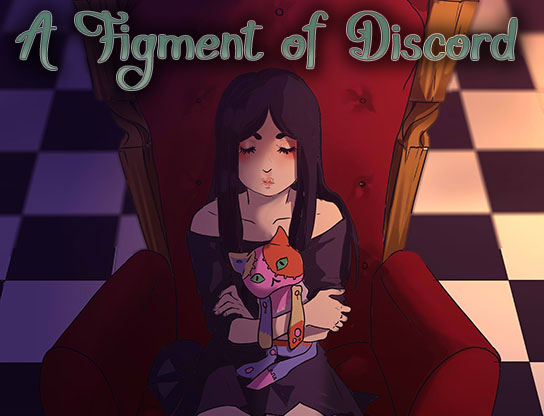
This is the first video game review that we have the pleasure, say (the nippings never are a pleasure) on Ludi Tarantula’s Archives.
The title in question is “A Figment of Discord” for two reasons:
-The first is because it was an invitation from the author herself. We certainly don’t think this is a good justification because maybe she didn’t expect this style of review, even on the one hand some of the comments left around on Facebook we hope that it could get an idea about the expressive form we use.
– The second reason is that the game was taken into account for the 2019 Misao nominations and this was a factor that puzzled us, because in this way an objective (and NOT subjective) vision of the product comes into play. What we hope, although there may be disagreement in the considerations, is that this nip can be a stimulus to try to apply the method of making criticism that has already been developed in the field of publishing books and films, to give examples, even on the Rpg Maker community.
Obviously who may have liked the game we have nothing to say, they are personal tastes, but when it comes to awards and nominations we take things seriously.
After all, however, since last year apparently a game full of plot holes like Aria’s Story had the recognition of impeccable storytelling we could not expect much.
FIRST WARNING
We would like to put this warning because of the acidic tones that might come out in the course of the review, it is in the norm nowadays to always worry about getting back right and not offending anyone in a spiral of goodwill often unjustified, but for critics we believe that these points are necessary: justification, association and/or dissociation towards other opinions, comparisons with other products and examples that can better explain the arguments that will be drawn up and entertainment .
If you do not use the catchy terms, phrases that can guide the reader and capture his interest: developing charisma is necessary to capture the attention of the public and often for this he puts the product reviewed back. The critic’s is still a profession.
Among our references for method and language we have them, which are just a few of the channels that in one field or another make the criticism followed and appreciated making irony – and some with a hint of acidity – their workhorse: let’s start with the Italians, like Ilenia Zodiaco, among the most followed rubrics definitely “Libri di melma“, that is among the best titles of the publishing trash; Yotobi who has not reviewed films for a long time but his style has influenced and been loved by many people, targeting, for entertainment, indefensible films; among the American critics a special mention to Nostalgia Critic that begins to talk about the products with introductory sketches, desecrated irony and eventually a way to think in a constructive point of view, and how to forget of course the video game critics. The channel of PlayerInside, passionates about cinema, too, and this certainly adds a more critical judgment on the script and direction of many video games and generally have a very professional approach to reviews, and almost a television approach for their news of the week, Parliamo di Videogiochi and the Angry Videogame Nerd, both youtubers that make pure entertainment, but presenting all the flaws and inconsistencies of the games they deal with, because precisely they deal both low-league games ( Fraws also treats those “Of bad taste”, but we are talking mainly about the series “Giochi Brutti “) for a very long time, creating very long-lived series, the column of Parliamo di Videogiochi is almost sixty episodes, and the American creator has built what is now a season-long web series, with at least a hundred episodes, of which many of us remember the opening (at least, the end of it): “He’s the angriest gamer you’ve ever heard, he’s the Angry Nintendo Nerd. He’s the Angry Atari Sega Nerd, he’s the Angry Videogame Nerd!”
WARNINGS FOR THE READER
In this review we will not be exempt from spoilers.
This part of the analysis will be managed in this way: we will follow everything from the beginning with a great summary, commenting on the logical choices that have been made. It is probable that in this part other aspects come out as directing and acting (as dubbing as in the initial clip and in the movements of the sprite) and other elements for which we will turn out to be picky and fussy.
Let’s start from the beginning…
The main title. A girl sitting on a throne with a puppet in her arms, a choice that will be unjustified and casual considering that there will be no suggestion throughout history that would suggest her as “queen” of something, neither from her point of view nor from that of the others. The artwork has a bumpy style unlike the half busts that will be shown in game, but this is a sore point that touches many other RPGs and on which we do not dwell.
The theme presents an accompaniment of five notes that follow one another and change the tone without ever arriving at a main melodic line, and it is precisely for this reason that we ask ourselves how it is possible that it was chosen as the main theme, especially when it returns in the music box: in the music boxes a melodic line is usually highlighted.
But let’s talk about the choices made in bulk that should correspond to the “New game”, “Continue”, and “Exit”: “Take a bite”, “Taste” … They are the same thing!
… If nothing else, the warnings before the introductory video are nice graphically, and we appreciated how they were made.
Let’s go to the introduction.
The dubbing. Let’s talk about it, it’s a disaster both in Italian and in English.
In Italian, however, the serious problems of expression and “falsification” of the voice are much more audible, even if in English (if you listen well) the voice really sounds … Inexpressive, but in the wrong sense of the term: it does not tell you nothing, and as in Italian the voice is very distorted, made it more “cute”. A voice actor does not distort the voice, change it, change it, but the voice is his. It will look like a small thing, but this video is the complete destruction of the dubber’s trade, which generally uses THEIR voice, but changes it, and does not falsify it so blatantly.
“But it’s an indie product, what do you expect?” I expect results similar to Sen’s voice lines in Mad Father (more than anything else we should give credit to the Vita-Chii site) Lydia in Aria’s Story (which, though not a great game, the voices were appreciable, and the author organizes real contests on Twitter for the voices of her characters), and for the cutscenes, if you want to put dubbing, I can mention Empty Sharp (another very valid Italian title) as example, with a truly masterful dubbing, even if done by guys for an amateur project!
The introduction is poorly thought out, written worse and … Really, since how much in a game there are no longer these types of introductions from the early 2000s on those online game sites that wanted to let you know in a nice way the characters of scarce platforms ?
The problem is not the choice itself: even the cliché can be considered a work of art if well exploited, but every choice must be thought with knowledge of the facts and awareness of what will be presented to the player.
For a writer it can be very important to take this “slogan” as a reference point: “show don’t tell” (which in an audiovisual product is then reflected in the direction).
A video game is an audiovisual art form, respect it. Like you did with the noise of children in the background, for example. It was a good start.
You could, however, disperse information about yourself as you explored the maps and interacted with the characters, or if you really wanted to summarize that information in a short time, why not do like “Up”, for example.
Of course, we mention the masters, who have summarized in a few minutes of film the life of a man, or “Rear Window”, in which only framing the photographs and objects in the protagonist’s room was revealed in a few seconds who he is, what he did and what happened to him in his wheelchair.
Let’s take examples right in the world of Horror RPGs.
“The Witch’s house” and the reading of the diaries as you go along the maps, in a video game there is more freedom for the author to manage information, which can be innovative, really pleasant to discover, as it was for the story of Ellen ending with the final revelation given by the letter, the first starting point with which we interacted.
And speaking of allegories? “Dreaming Mary” is an excellent title: the introduction is of few words, everything starts with the instructions given by the radio that want to suggest an almost despotic system for how information is provided and how the characters behave: they are clear, from the The first words they utter we immediately understand who they are and what they could represent, Boaris’s expressions transmit concern from the first meeting and every sentence seems built to give you the idea that this character represents something dirty: the sexual theme and the clues that speak of pedophilia are masterfully filtered by the attitudes and terms that the boar uses.
Let’s go to the summary.
Eris is a girl abandoned in an orphanage – a really poor and unusual orphanage on a realistic level, I mean, I don’t know if with so few guys she could be considered an institution in all respects, and if there really was a more important sub-plot in this regard it has never been minimally hinted at or deepened – and it immediately makes us understand that he has problems relating to others and to compensate for his loneliness he “created an imaginary friend”.
And the disease, you will say?
No, really, why the disease? How was it born? Eris suffers from solitude complexes from what we have seen, what would have resulted in her illness?
Other kids have also been orphans, but this is not enough to talk about mental disorder.
We will argue this point better towards the end, when we have all the information in hand.
Scenes in the present begin with this incipit: Eris and Millionmiles, the multicolored cat, are hungry, and let us understand that they are poorly fed in the orphanage.
There are some squabbles with the maids and then the agreement with Chantico takes place: the protagonist chooses, “for too much hunger” (but why? instead of a decent meal, without considering that he could ask Shiva for a favor as he considers him a petty thief) to give up his brooch for a treat, to be precise, and instead he finds himself with an apple.
All clear up here? Don’t you notice anything strange about issues? We’ll talk more about it later.
He feels cheated, the agreement is made, and he takes the decision to take it back in what should be “Abaddon”, his distortion of reality, and the events follow each other rather smoothly, if the other big problem does not come : the stake.
He could simply take the pin secretly and make up excuses, why get to the stake? Millionmiles?
But wasn’t it just his mental representation? What should Millionmiles represent at this moment? Suppose Eris wanted revenge for the deception he suffered.
If he wants revenge, it means that he is fully aware of who “the witch” is, he burns her to “wash away his sins” and then he wakes up the next morning.
The general panic is unleashed when it is discovered the next morning that Chantico has disappeared.
Leaving out that no one has noticed outside the orphanage – given the short distance that separates it from the place of the crime – I do not pretend to suspect traces of smoke, but at least the wood burned, but if Eris really thought totally disconnected because she would have to worry to remove the traces?
Yeah, what’s going on with Eris? Is she worried, is she feeling guilty?

Her total ignorance of murder is rather problematic: is she really only realizing now that she has killed Chantico? And we who thought it was a representation, a projection of what the girl represents for her. What’s the point of falling from the clouds now?
Who on earth thinks she killed then last night, a wicked witch totally randomly, why did she like doing it? Did you talk about punishments and sins, if you don’t realize the association you made on Chantico because then you made those speeches that would immediately become incongruent and out of context?
Hannah Arendt had analyzed an interesting question in the book “ Eichmann in Jerusalem: A Report on the Banality of Evil” (we talk about the historical context, but which, however, I am decontextualizing to exploit it in the argumentation), which often turns out to be the key to a psychopathic nature: these types of people generally they present a disturbance at the base which foresees the lack of empathy for the nature of the neighbor and they see it as an object, an instrument, or any representation that precludes even the only conception that can be its peer.
Eris wanted to be a representation of this disorder? The answer is unknown, confused.
The first act is concluded, making us understand that the division into chapters of history depends on the various murders that will be committed.
We then have the second murder, Sol.
We will only make a mention to the various endings: we think it is better to treat them in the part dedicated to gameplay, here we can only consider the boredom and the tremendous and false goodness that they cover, a special mention for the finale in which everyone remains alive.
“Oh, tiny sprouts! So we all knew that Moloch is a dirty villain? “
“Oh yes! Really?!”
“Oh golly, how many years did we spend the five of us in the dark, without know anything!“
“But why don’t we go against him now, running to defame him in the middle of the village?!”

Well, well, let’s get back to the main storyline.
The murder of Sol takes place with a certain bitterness: she seems to know what Eris has done, so I think the need to kill her is well justified even though she promised not to reveal anything: it is legitimate to suspect whether she will keep the word or not, if the act of leaving her alive would cause trouble.
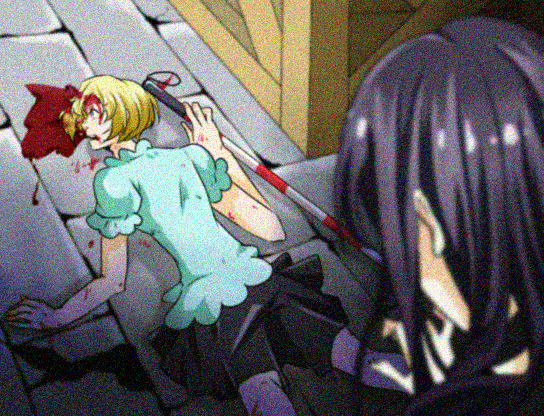
Let’s bring up the continual anatomical errors in the CG, which should be the “mother scenes” of the game. This title has been awarded for the drawings, they say.
The deaths follow each other in a natural way, or better, what remains: the very unlucky Mani.
His death is a suicide request, but before arriving at the end of the first part of the game we want to make a special mention to Glenn: how useless can his appearance be? It is a random way to justify its presence in the second part of the story, because it is completely normal that a stranger in a quiet walk decides, by chance, to inflict himself in an orphanage through a breach in the wall.
Breach, remember, kindly offered by Shiva: what genius, what mastery, why try to climb over the gates when you can be more suspicious and noisy when trying to smash a wall?
Another special mention goes to the Eris’ falcon eyes when in the realistic dialogue with Glenn – in which she prefers to tease him about his clothing rather than worry that a stranger cabbage has entered the structure – he thinks to himself “Oh, by how much time is that there this breach?”. She had never noticed it.
The point is that in RPG Maker the vision of the map is generally total, the player is able to notice everything, there is no gaze guided as in the cinema, so we consider that we follow Eris’s point of view: it is really possible that we wander around around for the map or just turning the head has never noticed a hole like that?
We also remember fondly the scene of when she dumped Glenn on the spot, without even worrying about a stranger being in the structure: she ignores him and leaves him there. Fantastic, nobody cares in that orphanage if Glenn could be a thief, a maniac.
But back to Mani’s suicide.
What we know about the character is that he is a sensitive person – obviously -, unlucky and hoping for a rapprochement with his sister Sol, his suicide choice came about precisely as a result of her death. This was one of the few remarkable, interesting choices that could be better developed.
Shortly after the wretch leaves us his feathers, he enters Shiva, the village punk boy, and with vivid surprise and upheaval he realizes what has happened.
Eris pushes him aside, not even the tuna takes care of chasing her, the music is always the same and the scene gives us so many emotions. But also no.
Nonchalantly, without even the slightest annoyance and diversity in her expressiveness, Eris communicates the latest events and turns them in his favor, blaming Shiva and exploiting the prejudice against him. Obviously not only no investigation was carried out on the part of the local police, but all the intent was not staged but communicated as a stark explanation between Eris’s thoughts.
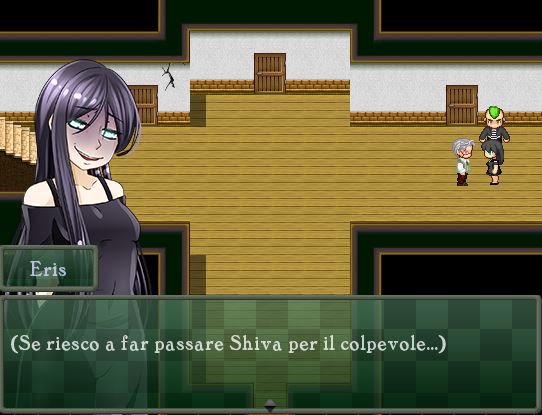
“If I make them think Shiva is the culprit…”
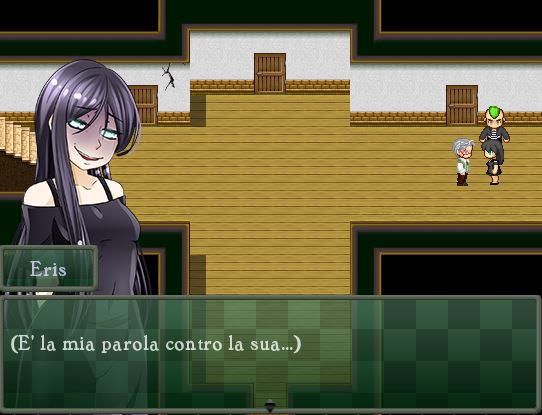
“It’s my word against his…”
And then, what happens? Only she and the director remained – obviously the orphanage was not even closed and Eris was not transferred – our protagonist decides to let Millionmiles go, making us understand that she feels guilty, especially for the ticket she finds later in the second part of the story; and then it is recalled by Moloch and there is a struggle.
A compelling and realistic scene in which they show themselves with text messages as the bad director is hurting poor Eris.

Scene from the movie “Primavera di Granito” –Leblanc’s death
A pursuit follows which ends with the sowing of Moloch. Who knows, maybe the old man will have had a heart attack. No really, no one knows what happened to him.
In any case in the second part of the story the point of view changes, after having had an intermezzo phrase: “I will be your family and I will take care of you”.
Well, now we have the point of view of Alys, the link with A Timeless Story and the question of marriage accomplished by necessity.
I agree, but what perplexes me always concerns the reasons for the event. The story seems to take place in modern times, if not contemporary. If Alys feels so uncomfortable about this marriage, could she ever try to find a job? The point is that we should not take anything for granted, even a brief information about it would have been enough.
Everything seems to flow very well from this point on, the exploration of the mansion becomes relaxing, if there were no problems related to the space-time relationship. Unfortunately you only want one category, you only want another one, there are many of them such in this part of the game.
One of the details undoubtedly concerns the letters, that is: we are talking about writing letters to people who in fact are just a few meters away, and who, on the other hand, decides to visit in person them the morning after the day on which the she writes these letters.
This was at least what seems to be apparent from the succession of events, because after the wedding night spent with the beloved Glenn – the marriage took place because it was indeed proposed to offer expenses to help Alys’ mother – it is not clear whether a temporal ellipse has occurred or if the events continue to take place the next morning, this derives from the great problem of directing that this product suffers.
Since she feels down she decides personally to visit her mother and had the idea of visiting Lysander as well; despite its textual words, it would have been “a long walk”.
Literally two steps away.
Now, I understand free interpretation and wanting to make this detail something smooth and not binding for the player, but the words should have been dosed differently. Or find other reasons that have led her to avoid all that time – how long it will actually be, days or months – to meet the people she cares about.
Her mother apparently continued to be left alone, and it does not seem that her desperate state of health could agree with what Glenn would have promised. Considering that Alys literally blew his own personal fulfillment, I imagined that as “the best care that can be offered” was protection from the indicated staff, yet Alys had nothing to object about the state of the mother who she died in total anonymity and let us remember that she left there. Nothing more was known about the corpse that probably after the last events of the history it will have remained in decay.
And then now Alys no longer has any reason to be interested in marriage and mansion, if he really finds himself so ill because he simply didn’t leave? Why did it actually suit her? Too bad that this character feature is never highlighted in any way.
The state of sadness and desperation of the characters makes sense when it is well justified.
And above all to think of having the ability to write means that there should be no need for the author’s justification, to feel the need to justify everything at a later time is done by those who are not aware of their work. The elements that are left to the interpretation and the elements that should be woven to build a logical plot are different things.
Let’s go back to the summary and see the new protagonist -or co-protagonist, as it would perhaps be more correct to call it on our part – who would like to ask someone for help but instead finds himself in front …
Eris? Oh man, how much hell have you grown up? It is a problem that concerns only this character: although after the pursuit with Moloch the direction lets us understand that in the meantime the other characters have passed, like Glenn himself – or Shiva who can be seen in one of the finals – have remained of the same aspect of past times.
If you consider changing character traits to indicate that time has been matched, it is quite useless to propose this disparity.
The presence of Eris makes Alys suspicious, Eris shows herself as a first woman unlike the cold and shy characterization she had as a young girl and even, asking for information from the servants, a maid informs that Eris, since she had fled, lived hidden in a room in the mansion!
Thing? Hidden in a room, really?
Why should he have? Were there any problems with the parents of his benefactor? And even if it were, once they died did it continue to remain hidden?
Or did he keep her locked up for fear that he might be a violent person? It’s a pity that Glenn never thought of it this way because in the final acts he sees himself clearly and nonchalantly that he considers her his lover.
Alys, as soon as she knows more about checking the scattered papers for the house, decides to go and visit the orphanage that was shown at the beginning of the game.
And then, what about the character of Lysander? Not answering when they knock on the door without even knowing who it is could indicate a state of great suffering which, however, is obliterated by their brief conversation in which they apologize, at least this is one of the scenes you would get if you decided to take the choice of get two finals that contain his presence.
You meet this character already in A Timeless Story indeed, but there his drama seemed to derive from a serious problem of distance, of physical distancing that concerned perhaps even in the escape in different countries, not that it remained anchored to the same village where his ex-lives playmate to throw a tantrum.
To get the Secret Ending – by the way, a secret ending from what we know should not be used to explain the main information on the story but only to add something more – you didn’t have to deal with Lysander, so we’ll continue to comment on the main storyline.
The part of the orphanage is boring and bland, perhaps it is however one of the few times – considering the story of Eris and excluding Alys – in which we try to recreate a climate that is in fact horror, even if following simple clichés.
About unjustified clichés: if spirits keep their characterizations even in death, why did they want to kill the co-star? The purification took place when he performed the ritual – by the way, a small logic problem that someone else has noticed is the fact that Alys knows exactly where to dig. Apparently everyone knew about Eris’s hideout, so does that mean they died with a pinch of bipolarity?
Here, however, Alys discovers that Eris carried out the murders, and the two endings vary depending on whether or not she is aware that they are actually sisters.
If he does not know it, True Ending follows and involves the drama: after one learns of the evil plan between Glenn and Eris, having a child – for … Why should two such people nurture both this desire? Would you like to indicate that in reality they are two good-hearted characters or at least that they hide an inner sensitivity given that they want to convey affection and education to a child? This is not how the characters would be justified, but two scoundrels remain -. Returning to the problem: having a child and using Alys to do so since Eris was wounded in the belly.
Then, Eris shoots her. In this final, on the other hand, Alys makes us understand that the demon sees it too, it is still present.
So … was Alys also sick in the end? Do they share the same blood and therefore share the hallucinations?
Why does the demon really exist then insist on talking about mental illnesses in a “raw and naked manner”?
There are other masters who talk about mental illness, which we repeat is a neurological problem, it differs according to the infected area and there are various causes, for example hereditary or due to trauma
Then we have the other embarrassing ending, the “Secret Ending”, or the “It doesn’t matter if you have killed people, you are my sister and I love you the same”, with a lot of closing comment from Glenn: “What an unexpected ending “.
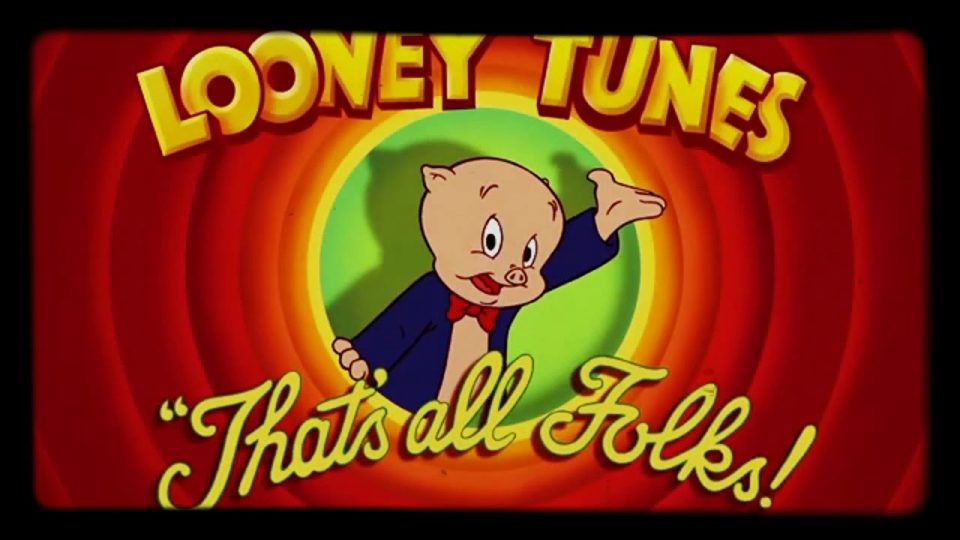
Ah yes, in all this does nothing escape you? Like the famous symbolism of the apple?
She has never returned since that conflict with Chantico had occurred.
The apple of Greek mythology was golden, because it would have gone to the most beautiful of the goddesses. The apple as a biblical symbol and the temptation in Adam and Eve was a forbidden fruit, in both cases we speak only of symbols with respect to something greater: man is selfish, he is not satisfied with what he possesses and he has more and more aspirations even if this involves his inner corruption.
Eris what aspiration would he have had? Satisfy your hunger with a treat. Yes, there is something wrong with this sentence.
There was talk of physical need, hunger and bad nutrition – he insisted on this point, it was considered one of the main motivations of his pact -.
There was not even a forced reminder, a little commitment in wanting, for example, to link this new characterization of Eris as an element that indicated the starting point: it was satisfied with the events that happened, because that deception was what he urged her to carry out the murders and thus be protected by Glenn living at home. I mean, hidden in her home.
It is a reasoning that draws water from all sides, in fact it speaks of recurring themes and symbols that should serve only as a communicative cue to communicate a type of message and a key theme, a narrative feature that is often commented and treated in screenwriting manuals and that films like “Dillinger is dead” have preferred to deal with irony and challenge: there is a gun that will condition the ending of the film, and it is continually cured and painted by the protagonist at home even without any sense.
Did he want to do some self-mockery? Given the uselessness of Glenn’s presence in the aforementioned scene, at least there could have been a quote to Raz Degan in the Italian movie Albakiara when he pronounced the joke: “The time of apples is over, whore!”.

And after the intertwining that the most gentle PaoGun has stripped us of, let’s move on to gameplay because, let’s remember, this is a video game, so you also have to talk about gameplay!
Surely you don’t expect a profound gameplay from a Horror RPG: for most of the games in this genre the gameplay consists only of puzzles and exploration. But the very simple one of this game… I swear I cried.
…Of despair.
The gameplay is too guided and forced when it shouldn’t: it’s not a video game, it’s a goddamn of interactive drama! Telltale Games, get out of the way! Midori Fragments have arrived with their phantasmagorical exploration phases! Each point will be very long, so I’ll divide it into paragraphs:
Map design
The maps are botched together and, being more outspoken than they have been right now, objectively horrible, with default assets misused, and even those downloaded were thrown into the treacherous maps, not even the shadow of a screen tint, which makes all the colors of places look flat and without depth, a perspective sometimes sent to the dump, together with the whole concept of map design.
And no, I do not accept the “But the part of the mansion there were lights!” As justification. On the contrary, it creates a great problem of inconsistency in the maps: it is very disrespectful towards gamers to make maps like this:
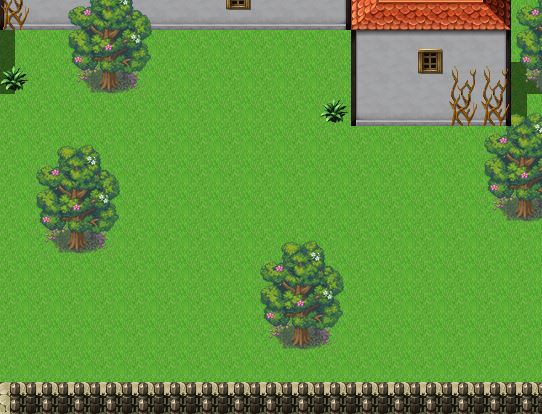
In the orphanage phase, where one should (theoretically) know all of Eris’s character, and the whole case of his murders in places significant to her.
Are these the significant places in her life?
A green expanse with some randomly planted trees, with giant concrete blocks?
You can’t go randomly with external maps! RPG Maker certainly does not help with them because let’s face it, the assets it provides for outsiders are quite mediocre, so you have to pay even more attention to external maps, just because they are much more difficult to do!
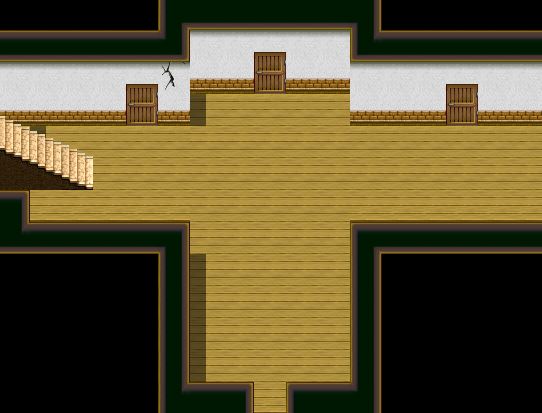
Or how can we not mention the wonderful corridors, with stone stairs?
Here too the same problem: an enormous expanse of a wooden tile with walls always and strictly by default; yes, I press a lot on this thing because the “original graphics” of this game were mentioned. Surprise: the maps are to be considered in the graphic section too!
Going back to the stairs, their position … I don’t even really know how to express myself. I will not dwell.
It must be said, at least, that small maps are not wicked, mainly because they do not have the problem of vast expanses of a single type of tile.
Going to the mansion, where the maps are more “cured”.
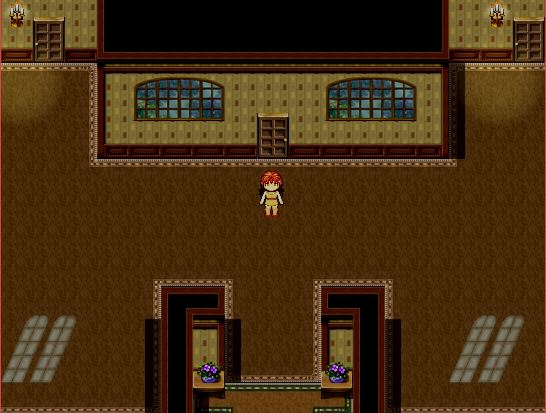
Certainly, certainly from the orphanage phase there is a clear improvement and it shows, but from here to say that the maps are more cured, it takes.
Yes, because there is the exact same pain of every map even minimally extended in this game! This gigantic carpet, which makes it look like everything, will never stop saying it, FLAT and without any effect of shadow and / or light, since they are given only by the light of the windows (crooked and badly made, moreover), from the lights of the candelabra (couldn’t you put the same script in the orphanage? It wouldn’t have hurt those maps!) and the screen color not even so preponderant, since its task was only to make the map a darker minimum.
In short, I don’t write the big problem of the maps of this game again, but simply “cure” a little more the maps only for a certain phase of the game, as I said it is disrespectful towards the players who expect a good quality from the I start at the end of their gameplay, and that “not being good at mapping” does not justify: if a person takes this great job (because being a map designer is a stressful job and with so many responsibilities) then or does it well, or if he is not good he must learn. Maps are absolutely not acceptable, if you want to make your game public, if you are presenting a product to an audience.
Gameplay
Now, after that long parenthesis on the maps, let’s move on to the juice of the question, to the showpiece.
I would like to start with a lack that seems to have not only bothered me, since I also got to see the video of another Italian youtuber who complained:
the race. In fact in the whole game you can’t run. Not even during the chases, so we find ourselves in these scenes where the protagonist says she has to run … But she doesn’t run. Go around with all the tranquility of this world.
This running problem could also be a small thing, if not for the reason of this choice and the effect it has on the gameplay.
Let’s start with the effect: it makes the whole thing much more frustrating, because the movements of Eris (or Alys) are not, very basic, very fast. So you walk in the already mentioned fantastic maps with 800 kg weights on your ankles, which don’t allow you to run and which make moving extremely slow, therefore frustrating for the player. Get ready, because I will often repeat the word “frustrating” when I talk about the gameplay of this game.
For the reason of all this, I have to give a small explanation of an external story.
When the game was published on the Italian forum RPG2s.com, many users had complained about the infidelity of “stealth” to Abaddon, which we will discuss later.
To solve the problem, therefore, instead of fixing the stealth phase, the run was completely removed. I understand why: this would have meant completely redoing that phase from the beginning, because it had actually been reported that there was a problem at the base, for the stealth one.
So the running option was taken out, but the whole game was boring to play. I want to applaud the genius of this choice, really.
But this stealth of which I talk so much about problems?
It was very simple in operation, actually: the red shadows move, if they see you it’s Game Over.
The problem is how it was done, which I already understood at first glance: a radius of action has been put into the events, if it reaches that range it is Game Over.
First of all: in every stealth as it should be, enemies must first see the player, before triggering the consequence (whether it’s a Game Over, or something else).
Then, the almost random movement was the great failure of this “stealth” phase, which actually translates into a “walk and pray“. I say “almost randomly”, because the pattern is so long and with random movements that I consider it, and I also exchanged it at first glance, like a random movement. Also because you have to go, in fact, also by chance for the directions of the sprites, because they themselves … They are not very eloquent! For this reason all this stealth does not become a good challenge, but simply frustrating, above allbecause the range of action is too wide, and this makes it almost impossible to do, given also the narrow map!
There was a stealth phase in another Horror RPG, which I’d like to take as an example: Mad Father.
The “cave” phase of the dolls. Remember it, right? Every Horror RPG player remembers it. There the dolls had a precise pattern of movement, but this did not make that phase extremely easy, indeed! The difficulty was given by the radius of action, at times, and above all by the speed of the dolls to move, and in the more advanced “levels” by the length of the patterns, and this caused the players to create a strategy, based on the information they had: speed, pattern, directions. This stealth, as I said, is extremely tedious to manage, since the movement of the red shadows you don’t know, so … Go randomly, praying that they don’t really see you, that you only wanted to go and save in the only available savefile.
Exactly! In this game you have only one save file for 9 endings! Argh!
Do you know what it means to have a single save file?! The player will have this perennial fear of making mistakes, or of taking what is not the true ending, and will always be afraid of having to start the game all over again!
When I played it, this choice already bothered me a lot, because it is obvious that a player prefers to have as much flexibility as possible with the save points – you, the author, don’t know what someone might try to do to play your game: if they maybe want to test some choice or even some death in a point of the game previous to the one in which they are, even just for fun (because, you know, the video game is first of all something that must entertain and amuse, many seem to have forgotten it), it is simply cruel to leave a limitation like this to someone who simply wants to have fun … Badly or not! So, let’s add to the list of frustrating elements of this game.
And then if only a save is made, the average Horror RPG player … Without being too exaggerated, but he has a perennial anxiety playing, if he wants the true ending! It should be illegal to give a similar anxiety to poor players who do not know about the infamous finals room, which we will talk about towards the end of this papyrus.
But I only scraped the tip of the iceberg.
The real, great, masterful, mammoth-sized problem that afflicts this title is the entire exploration phase, in general.
Finally, we got there!
What a grind … And there is still so much to say because, as mentioned at the beginning, the exploratory gameplay, which should be the simplest to bring on RPG Maker … It is not even discreet. Simply for a big problem that afflicts him, and that makes everything further, let’s repeat it together, frustrating!
Let’s take an example, it will be easier.
At some point in the game, during the endless exploration of Abaddon (where, on the other hand, as soon as we arrive we will find ourselves completely in jeopardy, after all that boring and very fast pace we had become used to), Eris will have to solve an enigma in the common room (don’t ask questions), it says:
“What color were the books?”
And the player wonders at this point
“What books ?!”
But don’t you remember them? The books on the bedside table directly above the bookcase, of which we all obviously remember the color! Poor us mere mortals that we see the colors of those books only once in passing and then ignore them, thinking they are an element of any scene!
According to this game, we must remember every single element of every single map … Otherwise we find ourselves in these situations! Because in theory we had to remember from the real world the color of the books, which are treated as normal stage elements, and not as elements to remember for an enigma, and then guess it to have only this information:
“Birds love sweet food and shiny things.”
“So…?”
The poor player asks.
“So you get to the most critical and senseless point of the gameplay!”
Finally we are at the focal point, which is actually very simple.
The concept is what I mentioned at the beginning of my review part …
All the gameplay is forced! Nothing is left to the player: if you don’t do this first, if you don’t activate this switch first, this doesn’t happen, even if you meticulously checked the room five minutes ago!
With this concept in mind we return to the riddle.
After having solved this riddle with a beautiful imprecation, let’s go back to blocking ourselves in the maps of Abaddon, where by now the BGM will already have entered our minds as the most annoying of the summer torments. Until we get back to the kitchen.

Eeh?!
What is a cake doing in the kitchen now that I sifted to perfection ten minutes ago ?!
It is simple: first the riddle had not been solved, so the cake did not appear. All logical, everything runs smoothly, doesn’t it? It’s not true.
According to the game, that note about birds that love shiny things and desserts had to serve something … Yes, but actually… No.
The player remembers that in the kitchen there is nothing, and therefore it is normal not to control it anymore, so this damn cake can find it only in a raptus of desperation in which he searches again, for the seventieth time, in all the rooms … But has activated the pie switch, so it can go on. I’m sorry to be dramatic, but I’m freaking out. It does not structure this way, a gameplay…
The problem is that these huge logic defects (which in the end affect the gameplay, and therefore the entire gameplay of A Figment of Discord) are there on daily basis, in all the exploratory phases, and therefore the predominant ones in these types of games, of this title! Yeah, if you don’t do what the game wants first, you can’t even take a very innocent key, and you know why?
Because if everything had been done according to logic, the order of events would have been totally busted, because there was … Indeed, I dare say that there is really no state, a terrible job in the integration of the enigmas, then of the “Phases in which you play”, in the plot, and therefore you have to resort to these stupid loopholes without logic, which only make the game more stressful, make it more … Guess what: frustrating!
So, in conclusion, the phases in which you get stuck in this game are not given by information that the player cannot understand, but which are given, but by information that the player does not receive!
… As another example, I would like to make a special mention to them. The unique and inimitable.
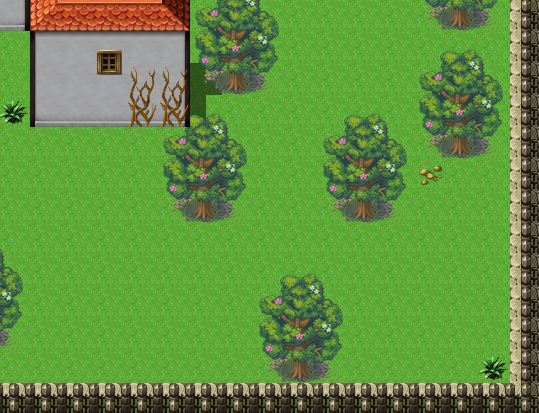
Did you see them?
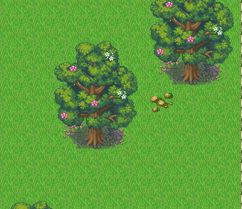
And now?

And now?
Those always damned stones that were inexplicably important!
Here we have a basic problem with the difference between props, and objects that are important for the plot. We have also seen it in books, right? But here we talk about where Eris kept his secret box, I don’t think he buried it so badly!
Thanks Midori Fragments.
Now let’s go back to a point I mentioned a little earlier, which ends my part of this exhausting review / slating.
Remember the endings room? Now let’s talk about it.
So, for these busy and well-kept endings we should rely on the “ending room”, which as a place does not really make sense on a logical level: what kind of room is that? Why are there doors that when opened take you back in time, probably creating 800 parallel dimensions? What is the function of the bonus room? Why should he say everything about the characters?
Why does all this exist?!
Surely many of you will already be with the keyboard in hand to mention Mogeko Castle … Well, it’s different there.
Mogeko Castle is full of these insane additions, it is one of its peculiarities, the nonsense. When you’re in that situation, so when you play at Mogeko Castle, make up your mind and think you don’t have to ask questions.
In Mogeko Castle, then, that room could very well be one of those of the castle, which as I said is full of these oddities, so a room with statues of all the characters, a kind of wardrobe to dress Yonaka, and all that already we know that we played Mogeko Castle … All this becomes almost normal, the player is used to the weird castle populated by yellow little creatures.
Even Misao, another RPG with a bonus room, had the supernatural factor to help it all.
Not here. They give you a plot that would also like to go on the “realistic”, and that does not aim absolutely at nonsense (indeed, this game also wants to be taken seriously), the places (apart from Abaddon) seem to be villages, houses, orphanages …
And in the end we find this gigantic carpet, 9 doors waiting for us and Millionmiles as a guardian to that cursed room.
And a question makes its way into my mind …
But how did we end up there?!
We cannot know it, we will only know that all those doors represent important divergences for the finals, and that if we unlock them all, the top door will open, showing the aforementioned bonus room.
Here … Instead of creating this damned room, you could very well give the player more freedom on when to save for an ending or another! These things piss me off so much, goddammit!
Because this room simply serves no purpose, and only gives useless information on the already mentioned forgettable characters, the useless origins of their names, is… A note from the author of the game. Let’s read it together.
“Hi, I’m Umi Nagisa, the founder of Midori Fragments, thank you for playing A Figment of Discord!”
Heartfelt thanks to you for making me angry, and at the same time entertaining, for a game like I had never played before. Thank you.
“If you had the patience to unlock all the endings, you must have really liked… I hope!”
… I continued it for science.
“How do you say? Would you like some anticipation on our next project? “
No! Please stand still! We’re all fine… Haha … Haha …
“I can only say that we will move away from the world of A Timeless Story and we will turn more to the fantastic realm.”
Well, so in addition to the problems of a fairly simple plot, there may be even more logical inconsistencies.
“You will never believe me, but an important clue to the plot has already been given within this game!”
I’m afraid I don’t understand. Enlighten me. Really, it’s an innocent request.
“I can’t say more! Continue to follow us on our social networks to stay up to date on current work, see you soon! “
And I also greet you, Umi, the whole Midori Fragments team, and I also greet you, poor survivors of all this slamming done with blood, sweat and tears.

Questa è la prima recensione videoludica che abbiamo il piacere, diciamo (le stroncature non mai tanto un piacere) su Ludi Tarantula’s Archives.
Il titolo in questione è “A Figment of Discord” per due motivi:
– Il primo è perché è stato un invito della stessa autrice. Sicuramente non pensiamo che questa sia una buona giustificazione perché magari non si aspettava questo stile di recensione, anche da una parte alcuni tra i commenti lasciati in giro su Facebook speriamo che sia potuta fare un’idea sulla forma espressiva che utilizziamo.
– Il secondo motivo è che il titolo in questione è stato preso in considerazione per le nomination dei Misao 2019 e questo è stato un fattore che ci ha lasciate perplesse. Quello che ci auguriamo, anche se potrebbe esserci disaccordo nelle considerazioni, è che questa stroncatura possa essere uno stimolo per tentare di applicare un metodo di fare critica anche su Rpg Maker che è stato già sviluppato in campo editoriale e cinematografico, per fare degli esempi.
Ovviamente a chi può essere piaciuto il gioco non abbiamo nulla da dire, sono gusti personali, ma quando si tratta di riconoscimenti e nomination prendiamo le cose seriamente, perché in questo modo entra in gioco una visione oggettiva (e NON soggettiva) del prodotto.
Del resto, tuttavia, essendo che l’anno scorso a quanto pare un gioco pieno di lacune come Aria’s Story abbia avuto il riconoscimento di narrazione impeccabile non potevamo aspettarci molto.
PRIMO AVVERTIMENTO
Ci teniamo a mettere questo avvertimento per via dei toni acidi che potrebbero venire fuori nel corso della recensione, è nella norma al giorno d’oggi di preoccuparsi sempre di rientrare nel giusto e non offendere nessuno in una spirale di buonismo spesso ingiustificato, ma per la critica crediamo che siano necessari questi punti: giustificazione, associazione e/o dissociazione nei confronti delle altre opinioni, confronti con altri prodotti ed esempi che possano spiegare meglio le argomentazioni che verranno stilate ed entertainment.
Se non si usano i termini accattivanti, frasi che possano guidare il lettore e cogliere il suo interesse: sviluppare il carisma è necessario per catturare l’attenzione del pubblico e spesso per questo ce ne rimette il prodotto recensito. Quella del critico è pur sempre una professione.
Tra i nostri riferimenti per il metodo ed il linguaggio abbiamo loro, che sono solo alcuni tra i canali che in un campo o nell’altro fanno della critica seguita e apprezzata rendendo dell’ironia –e alcuni con un pizzico di acidità– il loro cavallo di battaglia: cominciamo dagli italiani, come Ilenia Zodiaco, tra le rubriche più seguite senz’altro “Libri di melma”, ovvero tra i migliori titoli del trash editoriale; Yotobi che oramai non recensisce più film da tempo ma il suo stile ha influenzato ed è stato amato da moltissime persone, prendendo di mira, per entertainment, film indifendibili; tra i critici americani una menzione speciale a Nostalgia Critic che comincia a parlare dei prodotti con sketch introduttivi, ironia dissacrante e alla fine una riflessione e punto di vista costruttivo, e come dimenticare ovviamente i critici videoludici. I PlayerInside, appassionati di cinema, e ciò aggiunge sicuramente un giudizio più critico su sceneggiatura e regia di molti videogiochi e hanno in generale un approccio molto professionale alle recensioni, e quasi televisivo per le loro news della settimana, Parliamo Di Videogiochi e l’Angry Videogame Nerd, entrambi youtuber che fanno puro entertainment, presentando però tutti i difetti e le incongruenze dei giochi che trattano, perché appunto trattano entrambi giochi di bassa lega (Fraws tratta anche quelli “Di pessimo gusto”, ma stiamo parlando principalmente della serie “Giochi Brutti”) da moltissimo tempo, creando serie molto longeve, la rubrica di Parliamo di Videogiochi è quasi verso i sessanta episodi, e il creator americano ha costruito quella che ormai è una webserie a stagioni, con almeno un centinaio di episodi, di cui molti di noi ricordiamo la sigla (almeno, la fine): “He’s the angriest gamer you’ve ever heard, he’s the Angry Nintendo Nerd. He’s the Angry Atari Sega Nerd, he’s the Angry Videogame Nerd!”
Tutti loro sono stati per noi fonti di ispirazione, non riusciremo mai ad emularli e non è nemmeno questo l’intento, ma ci piace pensare che questo tipo di critica un giorno possa esistere anche per il mondo di Rpgmaker.
Detto questo, possiamo cominciare.
AVVERTENZE PER IL LETTORE
In questa recensione non ci esenteremo da spoiler.
Questa parte dell’analisi la gestiremo in questo modo: seguiremo il tutto dall’inizio con un grande riassunto, commentando le scelte logiche che sono state fatte. È probabile che in questa parte vengano fuori altri aspetti come regia e recitazione (in quanto doppiaggio come nella clip iniziale e nei movimenti delle sprite) e altri elementi per cui risulteremo pignole e puntigliose.
Cominciamo dall’inizio…
Il titolo. Una ragazza seduta su un trono con un pupazzo tra le braccia, scelta che risulterà ingiustificata e casuale considerando che non ci sarà nessun suggerimento nel corso della storia che la suggerisca come “regina” di qualcosa, né dal suo punto di vista né da quello degli altri. L’artwork ha uno stile sconnesso a differenza dei mezzi busti che verranno mostrate in game, ma questo è un tasto dolente che tocca molti altri Rpg e su cui non ci soffermiamo.
La theme presenta un accompagnamento di cinque note che si susseguono e cambiano la tonalità senza mai arrivare a una linea melodica principale, ed è proprio per questo motivo che ci chiediamo com’è possibile che sia stata scelta come main theme, soprattutto quando tornerà nel carillon: nei carillon solitamente viene messa in evidenza una linea melodica.
Ma parliamo delle scelte messe alla rinfusa che dovrebbero corrispondere al “Nuovo gioco”, “Continua”, ed “Esci”: “Dai un morso”, “Assaggia”… Sono la stessa cosa!
…Se non altro, le avvertenze prima del video introduttivo sono carine graficamente, e abbiamo apprezzato come sono state realizzate.
Andiamo all’introduzione.
Il doppiaggio. Parliamone, è un disastro sia in italiano che in inglese.
In italiano, però, i gravi problemi di espressione e di “falsazione” della voce sono molto più udibili, anche se pure in inglese (se si ascolta bene) la voce suona davvero… Inespressiva, ma nel senso sbagliato del termine: non ti comunica nulla, e come in italiano la voce è molto falsata, l’ha fatta più “carina”. Un doppiatore non falsa la voce, la muta, la cambia, ma la voce è la sua. Sembrerà una cosa da niente, ma questo video è la distruzione completa del mestiere del doppiatore, che usa generalmente la SUA voce, ma la cambia, e non la falsa in modo tanto palese.
“Ma è un prodotto indie, cosa ti aspetti?” Mi aspetto dei risultati simili alle voice lines di Sen in Mad Father (più che altro dovremmo dare credito al sito Vita-Chii) Lydia in Aria’s Story (che, per quanto non sia un gran gioco, le voci erano apprezzabili, e l’autrice organizza dei veri e propri contest su Twitter per le voci dei suoi personaggi), e per le cutscene, se vuoi mettere del doppiaggio, posso citare Empty Sharp (altro titolo italiano validissimo) come esempio, con un doppiaggio davvero magistrale, seppur fatto da ragazzi per un progetto amatoriale!
L’introduzione è pensata male, scritta peggio e…Davvero, da quant’è che in un gioco non esistono più questi tipi di introduzioni dai primi anni 2000 su quei siti di giochi online che volevano farti conoscere in maniera simpatica i personaggi dei platform scarsi?
Il problema non è la scelta in sé: anche il cliché può considerarsi un’opera d’arte se ben sfruttato, ma ogni scelta deve essere pensata con cognizione di causa e consapevolezza di quello che si presenterà al giocatore.
Per uno scrittore può essere molto importante prendere questo motto come punto di riferimento: “show don’t tell” (che in un prodotto audiovisivo poi si riflette nella regia).
Un videogioco è una forma d’arte audiovisiva, rispettala. Come hai fatto con il rumore dei bambini in sottofondo, per esempio. Era un buon inizio.
Potevi tuttavia disperdere le informazioni su di lei man mano che si esploravano le mappe e che si interagiva con i personaggi, o se proprio tenevi a riassumere in poco tempo quelle informazioni perché non fare come “Up”, ad esempio.
Certo, citiamo i maestri, che hanno riassunto in pochi minuti di film la vita di un uomo, oppure “La finestra sul cortile”, in cui solo inquadrando le fotografie e gli oggetti nella stanza del protagonista si è rivelato in pochi secondi chi è, cos’ha fatto e cosa gli è accaduto per trovarsi sulla sedia a rotelle.
Prendiamo degli esempi proprio nel mondo degli RPG Horror.
“The Witch’s house” e la lettura dei diari man mano che prosegui nelle mappe, in un videogioco c’è più libertà per l’autore nella gestione d’informazioni, che può rivelarsi innovativa, davvero gradevole da scoprire, come lo è stato per la storia di Ellen che si conclude con la rivelazione finale data dalla lettera, il primo elemento di partenza con cui abbiamo interagito.
E parlando di allegorie? “Dreaming Mary” è un ottimo titolo: l’introduzione è di poche parole, tutto comincia con le istruzioni date dalla radio che vogliono suggerire un sistema quasi dispotico per come vengono fornite le informazioni e come si comportano poi i personaggi: sono chiari, dalle prime parole che pronunciano capiamo immediatamente chi sono e cosa potrebbero rappresentare, le espressioni di Boaris trasmettono inquietudine sin dal primo incontro e ogni frase sembra costruita per darti l’idea che questo personaggio rappresenta qualcosa di sporco: la tematica sessuale e gli indizi che parlano della pedofilia sono magistralmente filtrati dagli atteggiamenti e dai termini che il cinghiale utilizza.
Andiamo al riassunto.
Eris è una ragazza abbandonata in un orfanotrofio –un orfanotrofio davvero povero e inusuale sul piano realistico, insomma, non so se con così pochi ragazzi poteva considerarsi un’istituzione a tutti gli effetti, e se davvero c’era una sotto-trama più importante a riguardo non è mai stata minimamente accennata o approfondita – e ci fa subito intendere che ha problemi a relazionarsi con gli altri e per compensare la sua solitudine si è “creata un amico immaginario”.
E la malattia, direte voi?
No, davvero, perché la malattia? Com’è nata? Eris soffre di complessi di solitudine da quanto abbiamo visto, cos’è che avrebbe scaturito la sua malattia?
Anche altri ragazzini sono stati orfani, ma questa non è una motivazione sufficiente per parlare di disturbo mentale.
Questo punto lo argomenteremo meglio verso il finale, quando avremo tutte le informazioni in mano.
Le scene al presente cominciano con quest’incipit: Eris e Millemiglia, il gatto multicolore, hanno fame, e ci lasciano intendere che nell’orfanotrofio vengono mal nutriti.
Ci sono alcuni battibecchi con le cameriere e poi avviene l’accordo con Chantico: la protagonista sceglie, “per la troppa fame” (ma perché? A breve avrebbero cenato, è una forzatura bella e buona considerando che si aspetta di ricevere leccornie e snack invece di un pasto decente, senza considerare che avrebbe potuto chiedere un favore a Shiva visto che lo considera un ladruncolo) di cedere la sua spilla per una leccornia, per l’appunto, e invece si ritrova con una mela.
Tutto chiaro fin qui? Non notate nulla di strano a proposito di tematiche? Ne parleremo meglio in fondo.
Si sente ingannata, l’accordo è fatto, e prende la decisione di riprendersela indietro in quella che dovrebbe essere “Abaddon”, la sua distorsione della realtà, e gli eventi si succedono in maniera piuttosto scorrevole, se non venisse l’altro grande problema: il rogo.
Avrebbe potuto semplicemente prendere la spilla di nascosto e inventarsi delle scuse, perché arrivare al rogo? Millemiglia?
Ma non era solo una sua rappresentazione mentale? Cosa dovrebbe rappresentare in questo momento Millemiglia? Supponiamo che Eris volesse vendicarsi per l’inganno che ha subito.
Se vuole vendicarsi significa che ha piena coscienza di chi sia “la strega”, la brucia per “lavare via i suoi peccati” e poi si risveglia la mattina successiva.
Il panico generale si scatena quando si scopre la mattina successiva che Chantico è sparita.
Tralasciando che nessuno abbia notato fuori dall’orfanotrofio –data la poca distanza che lo separa dal luogo del misfatto – non pretendo sospettare delle tracce di fumo, ma almeno la legna bruciata, ma se Eris pensava davvero in maniera totalmente disconnessa perché si sarebbe dovuta preoccupare di togliere le tracce?
Già, cosa sta succedendo ad Eris? Si sta preoccupando o si sta sentendo in colpa?

Piuttosto problematica la sua totale ignoranza sull’omicidio: si sta davvero rendendo conto solo ora di aver ucciso Chantico? E noi che pensavamo che fosse una rappresentazione, una proiezione di ciò che per lei rappresenta la ragazza. Che senso ha che cada dalle nubi ora?
Chi diamine pensa di aver ucciso allora la scorsa notte, una strega cattiva totalmente a caso, perché le piaceva farlo? Lei parlava di punizioni e peccati, se non si rende conto dell’associazione che ha fatto su Chantico perché allora ha fatto quei discorsi che diventerebbero immediatamente incongruenti e fuori contesto?
Hannah Arendt aveva analizzato una questione interessante nel libro “La banalità del male” (si parla dell’ambito storico, ma che tuttavia sto decontestualizzando per sfruttarlo nell’argomentazione), che spesso si rivela la chiave di una natura psicopatica: questi tipi di persone in genere presentano un disturbo alla base che prevede la mancanza di empatia per la natura del prossimo e lo vedono come un oggetto, uno strumento, o una qualsiasi rappresentazione che precluda anche la sola concezione che possa essere un suo pari.
Eris voleva essere una rappresentazione di questo disturbo? La risposta è ignota, confusa.
Il primo atto si conclude, facendoci comprendere che la divisione in capitoli della storia dipende dai vari omicidi che verranno commessi.
Abbiamo poi il secondo omicidio, Sol.
Faremo solo una menzione ai vari finali: quelli pensiamo sia meglio trattarli nella parte dedicata al gameplay, qui possiamo solo considerarne la noia e la bontà tremenda e falsa di cui si ricoprono, menzione speciale per il finale in cui tutti rimangono in vita.
“Oh, cavoletti! Quindi tutti sapevamo che Moloch è uno sporco villano?”
“Oh, sì! Davvero?!”
“Accidentolino, quanti anni abbiamo passato all’oscuro noi cinque!”
“Ma perché non gli andiamo contro ora, correndo a diffamarlo per il villaggio?!”

Beh, insomma, torniamo alla storyline principale.
L’omicidio di Sol si svolge con una certa amarezza: sembra sapere quello che Eris ha combinato, per questo ritengo ben giustificato la necessità di ucciderla nonostante avesse promesso di non rivelare nulla: è lecito che nascano dei sospetti se manterrà o meno la parola, se l’atto di lasciarla in vita avrebbe procurato dei guai.

Tiriamo in ballo i continui errori di anatomia nelle CG, che dovrebbero essere le “scene madri” del gioco. Questo titolo è stato premiato per i disegni, dicono.
Le morti si susseguono in maniera naturale, o meglio, quella che rimane: lo sfigatissimo Mani.
La sua morte è una richiesta di suicidio, ma prima di arrivare alla fine della prima parte del gioco vogliamo fare una menzione speciale a Glenn: quanto può essere inutile la sua comparsa? È un modo tirato a caso per giustificare la sua presenza nella seconda parte della storia, perché è totalmente normale che uno sconosciuto in una sua tranquilla passeggiata decida, così per caso, di inflitrarsi in un orfanotrofio tramite una breccia nel muro.
Breccia, ricordiamo, offerta gentilmente da Shiva: che genio, che maestria, perché provare a scavalcare i cancelli quando puoi risultare più sospetto e rumoroso nel cercare di frantumare un muro?
Altra menzione speciale vanno agli occhi di falco di Eris quando nel realistico dialogo con Glenn –in cui preferisce prenderlo in giro per il suo abbigliamento piuttosto che preoccuparsi che è entrato un cavolo di estraneo nella struttura– pensa tra sé e sé “Oh, da quant’è che c’è questa breccia?”. Non l’aveva mai notata.
Il punto è che in RPG Maker la visione della mappa è in genere totale, il giocatore riesce a notare tutto, non c’è lo sguardo guidato come nel cinema, per cui consideriamo che seguiamo il punto di vista di Eris: possibile davvero che gironzolando intorno per la mappa o solo voltando il capo non abbia mai notato un buco come quello?
Ricordiamo con affetto anche la scena di quando ha mollato Glenn su due piedi, senza nemmeno preoccuparsi che un estraneo sia nella struttura: lo ignora e lo lascia lì. Fantastico, non importa a nessuno in quell’orfanotrofio se Glenn potrebbe essere un ladro, un maniaco.
Ma torniamo al suicidio di Mani.
Ciò che sappiamo del personaggio è che è una persona sensibile –ovviamente–, sfortunata e che sperava in un riavvicinamento con la sorella Sol, la sua scelta di suicidio è avvenuta proprio in conseguenza alla morte di quest’ultima. Questa è stata una delle poche scelte notevoli, interessanti, che poteva essere sviluppata meglio.
Poco dopo che il disgraziato ci lascia le penne entra Shiva, il punkettaro del villaggio, e con vivida sorpresa e sconvolgimento si rende conto di quello che è accaduto.
Eris lo scansa , nemmeno il tonno si preoccupa di rincorrerla, la musica rimane sempre quella e la scena ci trasmette tantissime emozioni. Ma anche no.
Con nonchalance, senza nemmeno il minimo fastidio e diversità nella sua espressività, Eris comunica gli ultimi accadimenti e li rigira in proprio favore, dando la colpa proprio a Shiva e sfruttando il pregiudizio nei suoi confronti. Ovviamente non solo non è stata svolta nessuna indagine in merito da parte della polizia locale, ma tutto l’intento non è stato messo in scena ma comunicato come una spiegazione nuda e crude tra i pensieri di Eris.


E poi, cosa succede? Rimasta solo lei e il direttore –ovviamente l’orfanotrofio non è stato nemmeno chiuso ed Eris non è stata trasferita– la nostra protagonista decide di lasciar andare Millemiglia, facendoci intendere che prova dei sensi di colpa, soprattutto per il biglietto che si trova dopo nella seconda parte della storia; e poi viene richiamata da Moloch e si sussegue una colluttazione.
Un’avvincente e realistica scena in cui si mostrano con dei messaggi di testo come il cattivo direttore sta ferendo la povera Eris.

Scena da Primavera di Granito – La morte di Leblanc
Si sussegue un inseguimento che termina con la seminazione di Moloch. Chissà, forse gli sarà venuto un infarto al vecchiaccio. No davvero, non si sa più che fine abbia fatto.
In ogni caso nella seconda parte della storia il punto di vista cambia, dopo aver avuto una frase d’intermezzo: “Sarò io la tua famiglia e mi prenderò cura di te”.
Ebbene, ora abbiamo il punto di vista di Alys, il legame con A Timeless Story e la questione del matrimonio compiuto per necessità.
D’accordo, ma ciò che mi lascia perplessa riguardano sempre le motivazioni dell’avvenimento. La vicenda sembra svolgersi in tempi moderni, se non contemporanei. Se Alys si sente talmente a disagio per questo matrimonio, possibile che non abbia mai cercato di trovare un lavoro? Il punto è che non bisogna dare nulla per scontato, anche una breve informazione a riguardo sarebbe bastata.
Sembra scorrere tutto molto bene da questo punto in poi, l’esplorazione della magione diventa rilassante, se non si presentasse un problema legato al rapporto spazio-tempo.
Purtroppo vuoi solo una categoria vuoi solo un’altra, ce ne sono molte di falle del genere in questa parte del gioco.
Uno dei particolari riguardano senz’altro le lettere, ovvero: stiamo parlando di scrivere lettere a persone che difatti si trovano a pochi metri di distanza, e che per altro lei stessa decide di andare a trovare di persona la mattina successiva al giorno in cui le scrive.
Questo è stato perlomeno ciò che sembra trasparire dalla successione degli eventi, perché dopo la prima notte di nozze trascorsa con il beneamato Glenn –è avvenuto il matrimonio perché si era difatti proposto di offrire delle spese per aiutare la madre di Alys– non si comprende se è avvenuto un ellisse temporale o se le vicende continuino a svolgersi la mattina successiva, questo deriva dal grande problema di regia che questo prodotto soffre.
Dato che si sente giù decide personalmente di far visita a sua madre e aveva idea di far visita anche a Lysander; nonostante, sue testuali parole, sarebbe stata “una lunga camminata” .
Letteralmente due passi di distanza.
Ora, capisco la libera interpretazione e il voler rendere questo dettaglio qualcosa di scorrevole e non impegnativo per il giocatore, ma le parole sarebbero dovute essere dosate in maniera diversa. Oppure trovare altre motivazioni che l’hanno spinta ad evitare per tutto quel tempo –quanto tempo effettivamente sarà passato, giorni o mesi?– di andare incontro alle persone a cui tiene.
Sua madre a quanto pare continuava ad essere lasciata sola, e non sembra che il suo disperato stato di salute potesse concordare con quanto avrebbe promesso Glenn . Considerando che Alys ha letteralmente mandato all’aria la propria realizzazione personale, immaginavo che come “migliori cure che si possano offrire” fosse compresa una tutela da parte del personale indicato, eppure Alys non ha avuto nulla da obiettare a proposito dello stato della madre che è morta nel totale anonimato e ricordiamoci che ha lasciato lì. Non si è più saputo nulla sul cadavere che probabilmente a seguito degli ultimi avvenimenti della storia sarà rimasta in putrefazione.
E poi ora Alys non ha comunque più motivo per interessarsi al matrimonio e alla magione, se davvero si trova così male perché non se n’è semplicemente andata? Perché in realtà le faceva comodo? Peccato che questa caratteristica del personaggio non è mai risaltata in nessun modo.
Lo stato di tristezza e disperazione dei personaggi ha un senso quando viene ben giustificato.
E soprattutto pensare di avere la capacità di scrittura vuol dire che non dovrebbe esserci bisogno della giustificazione dell’autore, sentire il bisogno di giustificare tutto in un secondo momento lo fa chi non è cosciente del proprio lavoro. Sono diverse cose gli elementi che si lasciano all’interpretazione e gli elementi che dovrebbero tessersi per costruire una trama logica.
Torniamo al riassunto e vediamo la nuova protagonista –o coprotagonista, come forse sarebbe più corretto chiamarla da parte nostra– che vorrebbe chiedere aiuto a qualcuno ma invece si trova davanti…
Eris? Oh cavolo, quanto diamine sei cresciuta? È un problema che riguarda solo questo personaggio: nonostante dopo l’inseguimento con Moloch la regia ci lasci intendere che nel frattempo siano passati degli anni gli altri personaggi, come lo stesso Glenn – o Shiva che si intravede in uno dei finali– siano rimasti del medesimo aspetto dei tempi passati.
Se consideri di cambiare dei tratti dei personaggi per indicare che il tempo ha avuto riscontro è abbastanza inutile proporre questa disparità.
La presenza di Eris insospettisce Alys, Eris si mostra come una prima donna a differenza della caratterizzazione fredda e schiva che aveva da ragazzina e addirittura, chiedendo informazioni ai servitori, una cameriera comunica che Eris, da quando era fuggita, ha vissuto nascosta in una stanza nella magione!
Cosa? Nascosta in una stanza, davvero?
Perché avrebbe dovuto? C’erano problemi con i genitori del suo benefattore? E anche se fosse, una volta che sono morti ha continuato a rimanere nascosta?
Oppure l’ha tenuta rinchiusa per paura che potesse rivelarsi una persona violenta? Peccato che Glenn non l’abbia mai pensata in questo modo visto che negli atti finali si vede chiaramente e con nonchalance che la considera sua amante.
Alys, non appena ne sa di più controllando tra le carte disperse per la casa, decide di andare a visitare personalmente l’orfanotrofio che si è mostrato a inizio gioco
E poi, cosa dire sul personaggio di Lysander? Non rispondere quando bussano alla porta senza nemmeno sapere di chi si tratta potrebbe indicare uno stato di grande sofferenza che tuttavia viene obliterato dalla loro breve conversazione in cui si chiedono scusa, almeno questa è una delle scene che si otterrebbe se decidessi di intraprendere la scelta di ottenere due finali che contengono la sua presenza.
Si incontra questo personaggio già in A Timeless Story effettivamente, ma lì il suo dramma sembrava derivare da un serio problema di distanza, di allontanamento fisico che riguardava magari anche nella fuga in paesi diversi, non che rimanesse ancorato allo stesso villaggio dove vive la sua ex compagna di giochi a fare i capricci.
Per ottenere il Secret Ending –a proposito, un secret ending da quanto sappiamo non dovrebbe servire per spiegare delle informazioni principali sulla storia ma solo aggiungere qualcosa in più– non dovevi avere a che fare con Lysander, quindi continueremo a commentare la storyline principale.
La parte dell’orfanotrofio è noiosa e blanda, forse è tuttavia una delle poche volte –considerando la storia di Eris ed escludendo Alys– in cui si cerca di ricreare un clima difatti horror, anche se seguendo semplici cliché.
A proposito di cliché ingiustificati: se gli spiriti mantengono le loro caratterizzazioni anche nella morte, perché volevano uccidere la coprotagonista? La purificazione è avvenuta quando ha compiuto il rituale –a proposito, un piccolo problema di logica che ha notato anche qualcun altro è il fatto che Alys sappia esattamente dove scavare. A quanto pare tutti conoscevano il nascondiglio di Eris–, quindi vuol dire che sono morti con un pizzico di bipolarismo?
Qui comunque Alys scopre che Eris ha compiuto gli omicidi, e i due finali variano a seconda se lei sia a conoscenza o meno che in realtà sono sorelle.
Se non lo viene a sapere si sussegue il True Ending e comporta il drama: dopo che si viene a sapere del piano malefico tra Glenn ed Eris, avere un bambino –per…Perché due persone del genere dovrebbero nutrire entrambe questo desiderio? Vorrebbe indicare che in realtà sono due personaggi di buon cuore o comunque che nascondono una sensibilità interiore dato che vogliono trasmettere affetto ed educazione ad un bambino? Non è così che si giustificherebbero dei personaggi, rimangono comunque due canaglie–. Tornando al problema: avere un bambino e aver sfruttato Alys per farlo dato che Eris era rimasta ferita al ventre.
Poi, Eris la spara. In questo finale per altro Alys ci fa intendere che il demone lo vede anche lei, è ancora presente.
Allora…Era malata anche Alys, alla fine? Condividono lo stesso sangue e per tanto condividono le allucinazioni?
Perché se il demone esiste davvero allora si insiste nel parlare di malattie mentali in “maniera nuda e cruda”?
Sono altri i maestri che parlano della malattia mentale, che ripetiamo è un problema neurologico, si differenzia a seconda della zona infetta e ci sono varie cause, per esempio ereditarie o per traumi
Poi abbiamo l’altro imbarazzante finale, il “Secret Ending”, ovvero il “Non fa niente se hai ucciso delle persone, sei mia sorella e ti voglio bene lo stesso”, con tanto di commento di chiusura di Glenn: “Che finale inaspettato”.

Ah si, in tutto questo non vi sfugge niente? Tipo la famosa simbologia della mela?
Non è mai tornata da quando era avvenuto quel conflitto con Chantico.
La mela della mitologia greca era d’oro, perché sarebbe andata alla più bella tra le dee. La mela come simbolo biblico e della tentazione in Adamo ed Eva era un frutto proibito, si parla in entrambi i casi solamente di simboli rispetto a qualcosa di più grande: l’uomo è egoista, non si accontenta di ciò che possiede e ha sempre più aspirazioni anche se questo comporta la sua corruzione interiore.
Eris quale aspirazione avrebbe avuto? Soddisfare la propria fame con una leccornia. Sì, c’è qualcosa che non quadra in questa frase.
Si parlava di bisogno fisico, di fame e mal nutrizione –si insisteva su questo punto, è stata considerata una delle motivazioni principali del suo patto–.
Non c’è stato nemmeno un richiamo forzato, un po’ di impegno nel voler, ad esempio, collegare questa nuova caratterizzazione di Eris come elemento che indicava il punto di partenza: era soddisfatta degli avvenimenti accaduti, perché quell’inganno è stato ciò che l’ha spinta a compiere gli omicidi e quindi venire protetta da Glenn vivendo a casa sua. Cioè, nascosta a casa sua.
È un ragionamento che fa acqua da tutte le parti, si parla infatti di tematiche ricorrenti e simboli che dovrebbero servire solo come spunto comunicativo per comunicare un tipo di messaggio e una tematica chiave, una caratteristica narrativa che viene spesso commentata e trattata nei manuali di sceneggiatura e che film come “Dillinger è morto” hanno preferito trattare con ironia e sfida: c’è una pistola che condizionerà il finale del film, e viene continuamente curata e dipinta dal protagonista a casa propria anche senza alcun senso.
Voleva fare un po’ di autoironia? Visto l’inutilità della presenza di Glenn nella suddetta scena, almeno avrebbe potuto esserci una citazione a Raz Degan in Albakiara quando pronunciò la battuta: “È finito il tempo delle mele, puttana”.

E dopo l’intreccio che la gentilissima PaoGun ci ha spolpato, passiamo al gameplay perché, ricordiamolo, questo è un videogioco, quindi si deve parlare anche del gameplay!
Sicuramente non ci si aspetta un gameplay profondissimo da un RPG Horror: per la maggior parte dei giochi appartenenti a questo genere il gameplay consta solo di enigmi ed esplorazione. Ma quello anche semplicissimo di questo gioco… Giuro che ho pianto.
…Di disperazione.
Il gameplay è fin troppo guidato e forzato quando non dovrebbe: non è un videogioco, è un diamine di interactive drama! Telltale Games, togliti dai piedi! Sono arrivate le Midori Fragments con le loro fantasmagoriche fasi di esplorazione! Ogni punto sarà molto lungo, quindi lo dividerò in paragrafi:
Map design
Le mappe sono raffazzonate e, essendo più schietta di quanto non lo sono stata già adesso, oggettivamente orribili, con asset di default usati male, e pure quelli scaricati sono stati gettati nelle mappe a tradimento, neanche l’ombra di una tinta schermo, che fa sembrare tutti i colori dei luoghi piatti e senza profondità, prospettiva a volte mandata nella discarica, assieme all’intera concezione di map design.
E no, non accetto il “Ma alla parte della magione c’erano delle luci!” come giustificazione. Anzi, crea un grande problema di inconsistenza nelle mappe: è molto irrispettoso nei confronti dei videogiocatori fare delle mappe come questa:

Nella fase dell’orfanotrofio, dove si dovrebbe (in teoria) conoscere tutto il personaggio di Eris, e l’intero caso dei suoi omicidi nei luoghi significativi per lei.
Sono questi i luoghi significativi della sua vita?
Una distesa verde con qualche albero piantato a caso, con dei blocchi giganti di cemento?
Non si può andare a caso con le mappe esterne! RPG Maker non aiuta sicuramente con esse perché diciamocelo, gli asset che fornisce per gli esterni sono abbastanza mediocri, quindi bisogna avere un’attenzione anche maggiore per le mappe esterne, proprio perché molto più difficili da fare!

Oppure come possiamo non citare i meravigliosi corridoi, con le scale di pietra?
Anche qui lo stesso problema: una distesa enorme di un tile di legno con dei muri sempre e rigorosamente di default; si, premo molto su questa cosa perché furono citate le “grafiche originali” di questo gioco. Sorpresa: nel comparto grafico sono da considerare anche le mappe!
Tornando alle scale, la loro posizione… Non so neanche davvero come esprimermi. Non mi dilungo.
C’è da dire, almeno, che le mappe piccole non sono malvagie, principalmente perché non hanno il problema delle vaste distese di un solo tipo di tile.
Andando alla magione, dove le mappe sono più “curate”.

Certo, sicuramente dalla fase dell’orfanotrofio c’è un netto miglioramento e si vede, ma da qui a dire che le mappe sono più curate ce ne vuole.
Si, perché c’è lo stesso identico dolore di ogni mappa anche minimamente estesa di questo gioco! Questa moquette gigantesca, che fa sembrare tutto, non smetterò mai di dirlo, PIATTO e senza alcun effetto d’ombra e/o di luce, dato che essi sono dati solo dalla luce delle finestre (storte e messe male, d’altronde), dalle luci dei candelabri (non si poteva mettere lo stesso script nell’orfanotrofio? Non avrebbe fatto male, a quelle mappe!) e dalla tinta schermo neanche tanto preponderante, dato che il suo compito era solo rendere la mappa un minimo più scura.
Insomma, non scrivo ancora una volta il grande problema delle mappe di questo gioco, ma semplicemente “curare” un po’ di più le mappe solo per una certa fase del gioco, come dicevo è irrispettoso verso i giocatori che pretendono una buona qualità dall’inizio alla fine del loro gameplay, e che il “non essere bravi a fare mappe” non giustifica: se una persona si prende questo gran lavoro (perché essere un map designer è un lavoro stressante e con tante responsabilità) allora o lo fa bene, o se non è bravo deve imparare. Mappe così non sono assolutamente accettabili, se vuoi rendere il tuo gioco pubblico, se stai presentando un prodotto ad un pubblico.
Gameplay
Ora, dopo quella lunghissima parentesi sulle mappe, passiamo al succo della questione, al pezzo forte.
Vorrei iniziare con una mancanza che sembra non abbia dato fastidio solo a me, dato che ho anche avuto modo di vedere il video di un’altra youtuber italiana che se ne lamentava:
la corsa. Infatti in tutto il gioco non si può correre. Neanche durante gli inseguimenti, così ci si ritrova in queste scene dove la protagonista dice di dover correre… Ma non corre. Va in giro con tutta la tranquillità di questo mondo.
Questa della corsa potrebbe essere anche una piccolezza, se non per il motivo di questa scelta e l’effetto che ha sul gameplay.
Partiamo dall’effetto: rende il tutto molto più frustrante, perché i movimenti di Eris (o Alys) non sono, di base, molto veloci. Quindi cammini nelle già citate fantastiche mappe con dei pesi da 800 kg sulle caviglie, che non ti permettono di correre e che rendono il muoversi estremamente lento, quindi frustrante per il giocatore. Preparatevi, perché ripeterò spesso la parola “frustrante” quando parlerò del gameplay di questo gioco.
Per il motivo di tutto questo, mi tocca dare una piccola spiegazione di una storia esterna.
Quando fu pubblicato il gioco sul forum italiano RPG2s.com , molti utenti si erano lamentati dell’infattibilità dello “stealth” ad Abaddon, di cui parleremo dopo.
Per risolvere il problema, quindi, al posto di sistemare la fase stealth è stata tolta completamente la corsa. Capisco il perché: questo avrebbe comportato il rifare completamente quella fase dall’inizio, perché era stato effettivamente segnalato che c’era un problema alla base, per quello stealth.
Quindi è stata tolta la corsa, rendendo però l’intero gioco noioso da giocare. Voglio applaudire la genialità di questa scelta, davvero.
Ma questo stealth di cui tanto parlo che problemi aveva?
Era molto semplice come funzionamento, in realtà: le ombre rosse si muovono, se ti vedono è Game Over.
Il problema è il come è stato fatto, cosa che ho già capito al primo sguardo: è stato messo un raggio d’azione agli eventi, se si raggiunge quel raggio d’azione è Game Over.
Prima di tutto: in ogni stealth come si deve, i nemici devono prima di tutto vedere il giocatore, prima di far scattare la conseguenza (che sia un Game Over, o altro).
Poi, il movimento quasi casuale è stato il grande fallimento di questa fase “stealth”, che in realtà si traduce in un “walk and pray”. Dico “quasi a caso”, perché il pattern è così lungo e con movimenti messi a caso che lo considero, e l’ho anche scambiato a primo occhio, come un movimento casuale.Anche perché bisogna andare, appunto, a caso anche per le direzioni delle sprite, perché esse stesse… Non sono molto eloquenti! Per questo tutto questo stealth non diventa una bella sfida, ma semplicemente frustrante, soprattutto perché il raggio d’azione è troppo largo, e ciò rende il tutto quasi infattibile, data anche la mappa stretta!
C’era una fase stealth anche in un altro RPG Horror, che mi piacerebbe prendere d’esempio: Mad Father.
La fase della “caverna” delle bambole. La ricordate, no? Ogni giocatore di RPG Horror la ricorda. Lì le bambole avevano un pattern preciso di movimento, ma questo non rendeva quella fase estremamente facile, anzi! La difficoltà era data dal raggio d’azione, a volte, e soprattutto dalla velocità delle bambole a spostarsi, e nei “livelli” più avanzati dalla lunghezza dei pattern, e ciò faceva creare una strategia ai giocatori, in base alle informazioni che avevano: velocità, pattern, direzioni. Questo stealth, come dicevo, è estremamente tedioso da gestire, dato che il movimento delle ombre rosse non lo sai, quindi… Vai a caso, pregando che non vedano proprio te, che volevi solo andare a salvare nell’unico salvataggio disponibile.
Esatto! In questo gioco si ha solo un salvataggio per 9 finali! Argh!
Sapete cosa vuol dire avere un unico salvataggio?! Il giocatore avrà questa paura perenne di sbagliare, o di prendere quello che non è il true ending, e avrà sempre paura di dover ricominciare il gioco daccapo!
Quando lo giocai, già mi diede parecchio fastidio questa scelta, perché è ovvio che un giocatore preferisce avere più flessibilità possibile con i punti di salvataggio – tu, autore, non sai cosa potrebbe provare a fare qualcuno che gioca al tuo gioco: se magari testare qualche scelta o anche qualche morte in un punto del gioco precedente a quello in cui è, anche solo per divertimento (perché, sapete, il videogioco è prima di tutto qualcosa che deve intrattenere e divertire, molti sembrano averlo dimenticato), è semplicemente crudele lasciare una limitazione come questa a qualcuno che vuole semplicemente divertirsi… Male o meno! Quindi, aggiungiamo alla lista degli elementi frustranti di questo gioco.
E poi se viene messo solo un salvataggio, al giocatore medio di RPG Horror… Senza essere troppo esagerati, ma ha un’ansia perenne giocando, se vuole il true ending! Dovrebbe essere illegale dare un’ansia simile ai poveri giocatori che non sanno della famigerata stanza dei finali, di cui parleremo verso la fine di questo papiro.
Ma ho raschiato solo la punta dell’iceberg.
Il vero, grandissimo, magistrale, mastodontico problema che affligge questo titolo è l’intera fase di esplorazione, in generale.
Finalmente, ci siamo arrivati!
Che faticaccia… E c’è ancora tanto da dire perché, come detto all’inizio, il gameplay esplorativo, che dovrebbe essere il più semplice da portare su RPG Maker… Non è neanche discreto. Semplicemente per un grande problema che lo affligge, e che rende tutto ulteriormente, ripetiamolo insieme, frustrante!
Facciamo un esempio, risulterà più semplice.
Ad un certo punto del gioco, durante l’infinita esplorazione ad Abaddon (dove, d’altronde, appena arrivati ci ritroveremo completamente allo sbaraglio, dopo tutto quel e noiosissimo ritmo di gioco a cui ci eravamo ormai abituati), Eris dovrà risolvere un enigma nella sala comune (non fatevi domande), che dice
“Di che colore erano i libri?” E il giocatore si chiede, a questo punto:
“Quali libri?!”
Ma non li ricordate? I libri sul comodino direttamente sopra alla libreria, di cui ovviamente tutti ci ricordiamo il colore! Poveri noi, comuni mortali che i colori di quei libri li vediamo solo una volta di sfuggita e poi li ignoriamo, pensando siano un elemento di scena qualunque!
Secondo questo gioco, noi dobbiamo ricordare ogni singolo elemento di ogni singola mappa… Altrimenti ci ritroviamo in queste situazioni! Perché in teoria dovevamo ricordarci dal mondo reale il colore dei libri, che vengono trattati come normalissimi elementi di scena, e non come elementi da ricordare per un enigma, e poi indovinarlo per avere solo codesta informazione:
“I volatili adorano il cibo dolce e le cose luccicanti.”
“Quindi?”
Si chiede il povero giocatore.
“Quindi si arriva al punto più critico e insensato del gameplay!”
Finalmente siamo al punto focale, che in realtà è molto semplice.
Il concetto è quello che ho citato all’inizio della mia parte di recensione…
Tutto il gameplay è costretto! Nulla è lasciato al giocatore: se non fai prima questa cosa, se non attivi prima questo switch, questa cosa non accade, anche se hai controllato meticolosamente la stanza cinque minuti fa!
Con questo concetto in mente torniamo all’enigma.
Dopo aver risolto con una bella imprecazione quest’indovinello, torniamo a bloccarci nelle mappe di Abaddon, dove ormai la BGM ci sarà già entrata in testa come il più fastidioso dei tormentoni estivi. Finchè non torniamo in cucina.

Eeh?!
Che ci fa ora una torta nella cucina che avevo setacciato alla perfezione dieci minuti fa?!
E’ semplice: prima l’enigma non era stato risolto, quindi la torta non è apparsa. Tutto logico, fila tutto liscio, non è vero? Non è vero.
Secondo il gioco, quell’appunto sugli uccelli che amano le cose luccicanti e i dolci doveva servire a qualcosa… Si, ma attualmente… No.
Il giocatore ricorda che in cucina non c’è niente, e quindi viene normale non controllarla più, quindi questa dannata torta la può trovare solo in un raptus di disperazione in cui cerca di nuovo, per la settantesima volta, in tutte le stanze… Però ha attivato lo switch della torta, quindi può andare avanti. Mi dispiace essere drammatica, ma sto impazzendo. Non si struttura così, un gameplay…
Il problema è che questi grandissimi difetti di logica (che alla fine influiscono sul gameplay, e quindi sull’intera giocabilità di A Figment of Discord) sono il pane quotidiano di tutte le fasi esplorative, quindi quelle preponderanti in questi tipi di giochi, di questo titolo! Eh già, se prima non si fa quel che il gioco vuole, voi non potete neanche prendere un’innocentissima chiave, e sapete perché?
Perché se fosse stato fatto tutto secondo la logica, l’ordine degli eventi sarebbe stato totalmente sballato, perché c’è stato… Anzi, azzardo a dire che non c’è proprio stato, un lavoro terribile nell’integrazione degli enigmi, quindi delle “fasi in cui si gioca”, nella trama, e quindi bisogna ricorrere a questi stupidissimi escamotage senza logica, che rendono solo più stressante il gioco, lo rendono più, un’ultima volta, frustrante!
Quindi, concludendo, le fasi in cui ci si blocca in questo gioco non sono date da informazioni che il giocatore non riesce a recepire, ma che vengono date, bensì da informazioni che il giocatore non riceve proprio!
…Facendo un altro esempio, vorrei fare una menzione speciale a loro. Gli unici ed inimitabili.

Li avete visti?
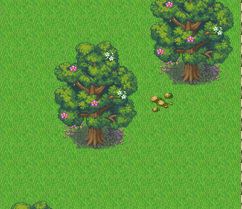
E adesso?

E adesso?
Quei sempre maledetti sassi che erano inspiegabilmente importanti!
Qui abbiamo un problema di fondo con la differenza tra oggetti di scena, e oggetti importanti per la trama. L’abbiamo visto anche nei libri, no? Ma qui si parla comunque di dove Eris ha tenuto il suo cofanetto segreto, non credo l’abbia seppellito tanto male!
Grazie Midori Fragments.
Ora torniamo ad un punto che avevo citato poco più sopra, che fa finire la mia parte di questa faticosissima recensione/stroncatura.
Ricordate la stanza dei finali? Ora ne parliamo.
Quindi, per questi impegnatissimi e curatissimi finali dovremmo affidarci alla “stanza dei finali”, che come luogo non ha proprio senso a livello logico: che razza di camera è quella? Perchè ci sono delle porte che quando aperte ti riportano indietro nel tempo, creando probabilmente 800 dimensioni parallele? Che funzione ha la stanza bonus? Perché dovrebbe dire tutto sui personaggi?
Perché tutto ciò esiste?!
Sicuramente molti di voi staranno già con la tastiera alla mano per citare Mogeko Castle… Ebbene, lì è diverso.
Mogeko Castle è strapieno di queste aggiunte demenziali, è una delle sue peculiarità, il nonsense. Quando sei in quella situazione, quindi quando giochi a Mogeko Castle, fai mente locale e pensi che non devi farti domande.
In Mogeko Castle, poi, quella stanza poteva essere benissimo una di quelle del castello, che come dicevo è pieno di queste stranezze, quindi una sala con le statue di tutti i personaggi, una specie di armadio per vestire Yonaka, e tutto ciò che già sappiamo noi che abbiamo giocato Mogeko Castle… Tutto ciò diventa quasi normale, il giocatore è abituato allo strambo castello popolato dagli esserini gialli.
Anche Misao, altro RPG con una stanza bonus, aveva il fattore soprannaturale ad aiutare il tutto.
Qui no. Ti propinano una trama che vorrebbe anche andare sul “realistico”, e che non punta assolutamente sul nonsense (anzi, questo gioco vuole anche farsi prendere sul serio), i luoghi (a parte Abaddon) sembrano essere villaggi, case, orfanotrofi…
E alla fine ci si ritrova questo tappeto gigantesco, 9 porte ad aspettarci e Millemiglia da guardiano a quella stanza maledetta.
E una domanda si fa strada nella mia mente…
Ma come ci siamo finiti?!
Non ci è dato saperlo, sapremo solo che tutte quelle porte rappresentano delle divergenze importanti per i finali, e che se li sbloccheremo tutti la porta in alto si aprirà, mostrando la già citata bonus room.
Ecco… Al posto di creare questa maledettissima stanza, si poteva benissimo dare più libertà al giocatore su quando salvare per avere un finale o un altro!
Perché semplicemente questa stanza non serve a nulla, e dà solo informazioni inutili sui già citati dimenticabili personaggi, le origini inutili dei loro nomi, è… Un appunto dell’autrice del gioco. Leggiamolo insieme.
“Ciao, sono Umi Nagisa, la fondatrice di Midori Fragments,grazie di cuore per aver giocato A Figment of Discord!”
Grazie di cuore a te che mi hai fatta arrabbiare, e allo stesso tempo divertire, per un gioco come non avevo mai fatto. Ti ringrazio.
“Se hai avuto la pazienza di sbloccare tutti i finali deve esserti piaciuto davvero… spero!”
…L’ho continuato per la scienza.
“Come dici? Vorresti qualche anticipazione sul nostro prossimo progetto?”
No! Vi prego, state ferme! Stiamo tutti bene così… Ahah… Haha…
“Posso dire soltanto che ci allontaneremo dal mondo di A Timeless Story e vireremo più sul fantastico.”
Bene, così oltre ai problemi di una trama anche abbastanza semplice, potrebbero esserci ancora più incongruenze a livello logico.
“Non mi crederai mai, ma un indizio importante sulla trama è stato già dato all’interno di questo gioco!”
Temo di non capire. Illuminami. Davvero, è una richiesta innocente.
“Non posso dire di più! Continuate a seguirci sui nostri social per restare sempre aggiornati sui lavori in corso, a presto!”
E anche io saluto te, Umi, tutto il team di Midori Fragments, e saluto anche voi, poveri sopravvissuti a tutta questa stroncatura fatta con sangue, sudore e lacrime.
Apri un sito e guadagna con Altervista - Disclaimer - Segnala abuso - Privacy Policy - Personalizza tracciamento pubblicitario